:max_bytes(150000):strip_icc():format(webp)/ps6-concept-trailer-64aac5b7323041ad93d7535eccf7df40.png)
2024 Approved Unraveling the Mystery How Premiere and After Effects Differ in Video Production

Unraveling the Mystery: How Premiere and After Effects Differ in Video Production
After Effects VS Adobe Premiere, 9 Differences Tell You Which One is Better?

Benjamin Arango
Mar 27, 2024• Proven solutions
This is perhaps the most asked question regarding video processing on the internet. And looking at the product descriptions on the Adobe site gives us a clue why. There seems to be a large overlap between the two programs, and technically there is, although as we shall see capability doesn’t always mean suitability, so the similarities are not quite as pronounced as they would appear.
With that in mind, it is worth looking at the key differences between After Effects and Premiere to get a clearer understanding of what is best for which situation and why you would pick one program over the other. So below are the 9 points that I will make a comparison.
Comparison Table
| After Effects | Adobe Premiere | |
|---|---|---|
| Price | $31.49/month | $31.49/month |
| Offcial Features | Create motion graphics and visual effects | Professional video and film editing |
| Includes 100GB of cloud storage | Includes 100GB of cloud storage | |
| Support | Phone/Live/Ticket/Training | Phone/Live/Ticket/Training |
| Users | Advanced/Average | Advanced/Average/Naive |
| Device | Win/Mac/Android/iPhone | Win/Mac/Android/iPhone |
This is a basic tutorial about Adobe Premiere, professional video editing software. However, if video editing is new to you, consider Wondershare Filmora , which is a powerful but easy-to-use tool for users just starting out. Download the free trial version below.
 Download Mac Version ](https://tools.techidaily.com/wondershare/filmora/download/ )
Download Mac Version ](https://tools.techidaily.com/wondershare/filmora/download/ )
After Effects VS Adobe Premiere
1Timeline
There are numerous editing differences between the two programs, but we will start with the timeline as it perhaps best illustrates the different focus of each package. Premiere has a very detailed timeline panel with a huge amount of functionality built in to move through and manipulate the contents of a project. After Effects, on the other hand, has less options for dealing with multiple clips and is designed to deal with the composite components in a more user friendly way.
The upshot of this would be the basic premise of the differences, for editing clips into a movie, whilst both can perform the task to an extent, Premiere’s timeline interface makes it a much easier process with many more options to make technical editing easier for the user.

2Editing
In addition to the timeline, Premiere has an interface and toolset built for precise editing and clip manipulation, both audio and video. This is not surprising of course, Premiere is after all first and foremost an editing package. By contrast, whilst there is editing functionality within After Effects, it is neither as user friendly, nor remotely as comprehensive a tool set, and as such would not be a suitable environment for extensive editing workflow.
This is perhaps the crux of the differences between the two packages, for editing work Premiere offers a complete toolset far beyond the requirements for many projects, but as comprehensive as one wishes, whilst After Effects is focus more on composites and motion video work and has an editing tool set that is not conducive to efficiency and ease of use.

3Audio Mixer
In today’s market the audio component on a video product can be as important as the visual aspects, the audio clip mixer within Premiere is a professional grade tool designed to offer precise control over a projects audio output and includes the ability to use VST3 industry standard plugins. Because After Effects is primarily a composite application it lacks the finesse of Premiere where audio is concerned. Again this shouldn’t be read as being an inferior program, it simply has a different focus.

4Mercury Playback Engine
In terms of perceived functionality probably not the top of the list, but Premiere uses this to employ either software (useful) or hardware (brilliant), assuming you have a compatible graphics card, accelerated real time renderless viewing of clips and sequences. This creates a much faster workflow for editing than is possible with After Effects beyond the previously mentioned tools and interface restrictions.

5 Multicam
In terms of editing this is where After Effects just isn’t comparable at all, the multi camera interface within Premiere is exceptionally featured and allows on the fly angle changes and edits and the ability to sync a single shot through numerous camera simultaneously. As said, the editing functionality on offer here is what Premiere exists for, and whilst both Premiere and After Effects are video manipulation packages, editing and composting are very different focuses, and the products reflect those differences.

6Media Management
Often overlooked but very important for project fidelity, the media management facilities within Premiere are designed around the needs of editing production and enable a much easier organizational approach for large projects than that of After Effects.

7Masking
This is where After Effects comes to the fore. The ability to create masks that track through scenes is a fundamental component of After Effects workflow and why it is so good for effects creation and compositing. None of these effects are readily achievable within Premiere as it ships, and even add ons will never achieve the fluidity and ease of use the purpose designed interface provides.

8 Camera Tracker
The 3D camera tracker within After Effects is an incredibly useful tool designed to replicate the camera movements within a given scene to allow new layers to be added that precisely match the original scene, essential for composite work and simply not possible within Premiere.

9 Effects
The collection of specific tools within After Effects for applying motion control effects, for color control, blurring shadows transitions and titles is vast, and whilst Premiere includes some of its own, it is clear that here After Effects has the edge and it once again highlights the different approach taken by each program. Premiere is primarily an editing application, it is designed to enable the fastest, most efficient and highest quality non-linear editing of a project possible. Within that framework it includes the ability, both natively and with plugins, to incorporate a limited range transitions and effects to aid the editing process.
After Effects, however, is an application built around effects, it is designed to allow an almost unlimited variety of effects, transitions and animations to be incorporated into a project via compositing and as such has a wealth of tools to enable the efficient workflow of those tasks, including some editing tools that would likely be needed for that job.

Conclusion
I’ve seen it explained before in terms of Word and Excel. You can compose a letter in Excel and create a spreadsheet in Word with the tables functionality, but the end result will take much longer and never be quite as good doing it that way. This perhaps is the best way to explain the relationship between Premiere and After Effects.
Yes, a spec sheet makes the two programs seem somewhat comparable, but it is the focus of each application that shows why they differ so much. Ultimately, the best use of these programs is together, they complement each other perfectly.

Benjamin Arango
Benjamin Arango is a writer and a lover of all things video.
Follow @Benjamin Arango
Benjamin Arango
Mar 27, 2024• Proven solutions
This is perhaps the most asked question regarding video processing on the internet. And looking at the product descriptions on the Adobe site gives us a clue why. There seems to be a large overlap between the two programs, and technically there is, although as we shall see capability doesn’t always mean suitability, so the similarities are not quite as pronounced as they would appear.
With that in mind, it is worth looking at the key differences between After Effects and Premiere to get a clearer understanding of what is best for which situation and why you would pick one program over the other. So below are the 9 points that I will make a comparison.
Comparison Table
| After Effects | Adobe Premiere | |
|---|---|---|
| Price | $31.49/month | $31.49/month |
| Offcial Features | Create motion graphics and visual effects | Professional video and film editing |
| Includes 100GB of cloud storage | Includes 100GB of cloud storage | |
| Support | Phone/Live/Ticket/Training | Phone/Live/Ticket/Training |
| Users | Advanced/Average | Advanced/Average/Naive |
| Device | Win/Mac/Android/iPhone | Win/Mac/Android/iPhone |
This is a basic tutorial about Adobe Premiere, professional video editing software. However, if video editing is new to you, consider Wondershare Filmora , which is a powerful but easy-to-use tool for users just starting out. Download the free trial version below.
 Download Mac Version ](https://tools.techidaily.com/wondershare/filmora/download/ )
Download Mac Version ](https://tools.techidaily.com/wondershare/filmora/download/ )
After Effects VS Adobe Premiere
1Timeline
There are numerous editing differences between the two programs, but we will start with the timeline as it perhaps best illustrates the different focus of each package. Premiere has a very detailed timeline panel with a huge amount of functionality built in to move through and manipulate the contents of a project. After Effects, on the other hand, has less options for dealing with multiple clips and is designed to deal with the composite components in a more user friendly way.
The upshot of this would be the basic premise of the differences, for editing clips into a movie, whilst both can perform the task to an extent, Premiere’s timeline interface makes it a much easier process with many more options to make technical editing easier for the user.

2Editing
In addition to the timeline, Premiere has an interface and toolset built for precise editing and clip manipulation, both audio and video. This is not surprising of course, Premiere is after all first and foremost an editing package. By contrast, whilst there is editing functionality within After Effects, it is neither as user friendly, nor remotely as comprehensive a tool set, and as such would not be a suitable environment for extensive editing workflow.
This is perhaps the crux of the differences between the two packages, for editing work Premiere offers a complete toolset far beyond the requirements for many projects, but as comprehensive as one wishes, whilst After Effects is focus more on composites and motion video work and has an editing tool set that is not conducive to efficiency and ease of use.

3Audio Mixer
In today’s market the audio component on a video product can be as important as the visual aspects, the audio clip mixer within Premiere is a professional grade tool designed to offer precise control over a projects audio output and includes the ability to use VST3 industry standard plugins. Because After Effects is primarily a composite application it lacks the finesse of Premiere where audio is concerned. Again this shouldn’t be read as being an inferior program, it simply has a different focus.

4Mercury Playback Engine
In terms of perceived functionality probably not the top of the list, but Premiere uses this to employ either software (useful) or hardware (brilliant), assuming you have a compatible graphics card, accelerated real time renderless viewing of clips and sequences. This creates a much faster workflow for editing than is possible with After Effects beyond the previously mentioned tools and interface restrictions.

5 Multicam
In terms of editing this is where After Effects just isn’t comparable at all, the multi camera interface within Premiere is exceptionally featured and allows on the fly angle changes and edits and the ability to sync a single shot through numerous camera simultaneously. As said, the editing functionality on offer here is what Premiere exists for, and whilst both Premiere and After Effects are video manipulation packages, editing and composting are very different focuses, and the products reflect those differences.

6Media Management
Often overlooked but very important for project fidelity, the media management facilities within Premiere are designed around the needs of editing production and enable a much easier organizational approach for large projects than that of After Effects.

7Masking
This is where After Effects comes to the fore. The ability to create masks that track through scenes is a fundamental component of After Effects workflow and why it is so good for effects creation and compositing. None of these effects are readily achievable within Premiere as it ships, and even add ons will never achieve the fluidity and ease of use the purpose designed interface provides.

8 Camera Tracker
The 3D camera tracker within After Effects is an incredibly useful tool designed to replicate the camera movements within a given scene to allow new layers to be added that precisely match the original scene, essential for composite work and simply not possible within Premiere.

9 Effects
The collection of specific tools within After Effects for applying motion control effects, for color control, blurring shadows transitions and titles is vast, and whilst Premiere includes some of its own, it is clear that here After Effects has the edge and it once again highlights the different approach taken by each program. Premiere is primarily an editing application, it is designed to enable the fastest, most efficient and highest quality non-linear editing of a project possible. Within that framework it includes the ability, both natively and with plugins, to incorporate a limited range transitions and effects to aid the editing process.
After Effects, however, is an application built around effects, it is designed to allow an almost unlimited variety of effects, transitions and animations to be incorporated into a project via compositing and as such has a wealth of tools to enable the efficient workflow of those tasks, including some editing tools that would likely be needed for that job.

Conclusion
I’ve seen it explained before in terms of Word and Excel. You can compose a letter in Excel and create a spreadsheet in Word with the tables functionality, but the end result will take much longer and never be quite as good doing it that way. This perhaps is the best way to explain the relationship between Premiere and After Effects.
Yes, a spec sheet makes the two programs seem somewhat comparable, but it is the focus of each application that shows why they differ so much. Ultimately, the best use of these programs is together, they complement each other perfectly.

Benjamin Arango
Benjamin Arango is a writer and a lover of all things video.
Follow @Benjamin Arango
Benjamin Arango
Mar 27, 2024• Proven solutions
This is perhaps the most asked question regarding video processing on the internet. And looking at the product descriptions on the Adobe site gives us a clue why. There seems to be a large overlap between the two programs, and technically there is, although as we shall see capability doesn’t always mean suitability, so the similarities are not quite as pronounced as they would appear.
With that in mind, it is worth looking at the key differences between After Effects and Premiere to get a clearer understanding of what is best for which situation and why you would pick one program over the other. So below are the 9 points that I will make a comparison.
Comparison Table
| After Effects | Adobe Premiere | |
|---|---|---|
| Price | $31.49/month | $31.49/month |
| Offcial Features | Create motion graphics and visual effects | Professional video and film editing |
| Includes 100GB of cloud storage | Includes 100GB of cloud storage | |
| Support | Phone/Live/Ticket/Training | Phone/Live/Ticket/Training |
| Users | Advanced/Average | Advanced/Average/Naive |
| Device | Win/Mac/Android/iPhone | Win/Mac/Android/iPhone |
This is a basic tutorial about Adobe Premiere, professional video editing software. However, if video editing is new to you, consider Wondershare Filmora , which is a powerful but easy-to-use tool for users just starting out. Download the free trial version below.
 Download Mac Version ](https://tools.techidaily.com/wondershare/filmora/download/ )
Download Mac Version ](https://tools.techidaily.com/wondershare/filmora/download/ )
After Effects VS Adobe Premiere
1Timeline
There are numerous editing differences between the two programs, but we will start with the timeline as it perhaps best illustrates the different focus of each package. Premiere has a very detailed timeline panel with a huge amount of functionality built in to move through and manipulate the contents of a project. After Effects, on the other hand, has less options for dealing with multiple clips and is designed to deal with the composite components in a more user friendly way.
The upshot of this would be the basic premise of the differences, for editing clips into a movie, whilst both can perform the task to an extent, Premiere’s timeline interface makes it a much easier process with many more options to make technical editing easier for the user.

2Editing
In addition to the timeline, Premiere has an interface and toolset built for precise editing and clip manipulation, both audio and video. This is not surprising of course, Premiere is after all first and foremost an editing package. By contrast, whilst there is editing functionality within After Effects, it is neither as user friendly, nor remotely as comprehensive a tool set, and as such would not be a suitable environment for extensive editing workflow.
This is perhaps the crux of the differences between the two packages, for editing work Premiere offers a complete toolset far beyond the requirements for many projects, but as comprehensive as one wishes, whilst After Effects is focus more on composites and motion video work and has an editing tool set that is not conducive to efficiency and ease of use.

3Audio Mixer
In today’s market the audio component on a video product can be as important as the visual aspects, the audio clip mixer within Premiere is a professional grade tool designed to offer precise control over a projects audio output and includes the ability to use VST3 industry standard plugins. Because After Effects is primarily a composite application it lacks the finesse of Premiere where audio is concerned. Again this shouldn’t be read as being an inferior program, it simply has a different focus.

4Mercury Playback Engine
In terms of perceived functionality probably not the top of the list, but Premiere uses this to employ either software (useful) or hardware (brilliant), assuming you have a compatible graphics card, accelerated real time renderless viewing of clips and sequences. This creates a much faster workflow for editing than is possible with After Effects beyond the previously mentioned tools and interface restrictions.

5 Multicam
In terms of editing this is where After Effects just isn’t comparable at all, the multi camera interface within Premiere is exceptionally featured and allows on the fly angle changes and edits and the ability to sync a single shot through numerous camera simultaneously. As said, the editing functionality on offer here is what Premiere exists for, and whilst both Premiere and After Effects are video manipulation packages, editing and composting are very different focuses, and the products reflect those differences.

6Media Management
Often overlooked but very important for project fidelity, the media management facilities within Premiere are designed around the needs of editing production and enable a much easier organizational approach for large projects than that of After Effects.

7Masking
This is where After Effects comes to the fore. The ability to create masks that track through scenes is a fundamental component of After Effects workflow and why it is so good for effects creation and compositing. None of these effects are readily achievable within Premiere as it ships, and even add ons will never achieve the fluidity and ease of use the purpose designed interface provides.

8 Camera Tracker
The 3D camera tracker within After Effects is an incredibly useful tool designed to replicate the camera movements within a given scene to allow new layers to be added that precisely match the original scene, essential for composite work and simply not possible within Premiere.

9 Effects
The collection of specific tools within After Effects for applying motion control effects, for color control, blurring shadows transitions and titles is vast, and whilst Premiere includes some of its own, it is clear that here After Effects has the edge and it once again highlights the different approach taken by each program. Premiere is primarily an editing application, it is designed to enable the fastest, most efficient and highest quality non-linear editing of a project possible. Within that framework it includes the ability, both natively and with plugins, to incorporate a limited range transitions and effects to aid the editing process.
After Effects, however, is an application built around effects, it is designed to allow an almost unlimited variety of effects, transitions and animations to be incorporated into a project via compositing and as such has a wealth of tools to enable the efficient workflow of those tasks, including some editing tools that would likely be needed for that job.

Conclusion
I’ve seen it explained before in terms of Word and Excel. You can compose a letter in Excel and create a spreadsheet in Word with the tables functionality, but the end result will take much longer and never be quite as good doing it that way. This perhaps is the best way to explain the relationship between Premiere and After Effects.
Yes, a spec sheet makes the two programs seem somewhat comparable, but it is the focus of each application that shows why they differ so much. Ultimately, the best use of these programs is together, they complement each other perfectly.

Benjamin Arango
Benjamin Arango is a writer and a lover of all things video.
Follow @Benjamin Arango
Benjamin Arango
Mar 27, 2024• Proven solutions
This is perhaps the most asked question regarding video processing on the internet. And looking at the product descriptions on the Adobe site gives us a clue why. There seems to be a large overlap between the two programs, and technically there is, although as we shall see capability doesn’t always mean suitability, so the similarities are not quite as pronounced as they would appear.
With that in mind, it is worth looking at the key differences between After Effects and Premiere to get a clearer understanding of what is best for which situation and why you would pick one program over the other. So below are the 9 points that I will make a comparison.
Comparison Table
| After Effects | Adobe Premiere | |
|---|---|---|
| Price | $31.49/month | $31.49/month |
| Offcial Features | Create motion graphics and visual effects | Professional video and film editing |
| Includes 100GB of cloud storage | Includes 100GB of cloud storage | |
| Support | Phone/Live/Ticket/Training | Phone/Live/Ticket/Training |
| Users | Advanced/Average | Advanced/Average/Naive |
| Device | Win/Mac/Android/iPhone | Win/Mac/Android/iPhone |
This is a basic tutorial about Adobe Premiere, professional video editing software. However, if video editing is new to you, consider Wondershare Filmora , which is a powerful but easy-to-use tool for users just starting out. Download the free trial version below.
 Download Mac Version ](https://tools.techidaily.com/wondershare/filmora/download/ )
Download Mac Version ](https://tools.techidaily.com/wondershare/filmora/download/ )
After Effects VS Adobe Premiere
1Timeline
There are numerous editing differences between the two programs, but we will start with the timeline as it perhaps best illustrates the different focus of each package. Premiere has a very detailed timeline panel with a huge amount of functionality built in to move through and manipulate the contents of a project. After Effects, on the other hand, has less options for dealing with multiple clips and is designed to deal with the composite components in a more user friendly way.
The upshot of this would be the basic premise of the differences, for editing clips into a movie, whilst both can perform the task to an extent, Premiere’s timeline interface makes it a much easier process with many more options to make technical editing easier for the user.

2Editing
In addition to the timeline, Premiere has an interface and toolset built for precise editing and clip manipulation, both audio and video. This is not surprising of course, Premiere is after all first and foremost an editing package. By contrast, whilst there is editing functionality within After Effects, it is neither as user friendly, nor remotely as comprehensive a tool set, and as such would not be a suitable environment for extensive editing workflow.
This is perhaps the crux of the differences between the two packages, for editing work Premiere offers a complete toolset far beyond the requirements for many projects, but as comprehensive as one wishes, whilst After Effects is focus more on composites and motion video work and has an editing tool set that is not conducive to efficiency and ease of use.

3Audio Mixer
In today’s market the audio component on a video product can be as important as the visual aspects, the audio clip mixer within Premiere is a professional grade tool designed to offer precise control over a projects audio output and includes the ability to use VST3 industry standard plugins. Because After Effects is primarily a composite application it lacks the finesse of Premiere where audio is concerned. Again this shouldn’t be read as being an inferior program, it simply has a different focus.

4Mercury Playback Engine
In terms of perceived functionality probably not the top of the list, but Premiere uses this to employ either software (useful) or hardware (brilliant), assuming you have a compatible graphics card, accelerated real time renderless viewing of clips and sequences. This creates a much faster workflow for editing than is possible with After Effects beyond the previously mentioned tools and interface restrictions.

5 Multicam
In terms of editing this is where After Effects just isn’t comparable at all, the multi camera interface within Premiere is exceptionally featured and allows on the fly angle changes and edits and the ability to sync a single shot through numerous camera simultaneously. As said, the editing functionality on offer here is what Premiere exists for, and whilst both Premiere and After Effects are video manipulation packages, editing and composting are very different focuses, and the products reflect those differences.

6Media Management
Often overlooked but very important for project fidelity, the media management facilities within Premiere are designed around the needs of editing production and enable a much easier organizational approach for large projects than that of After Effects.

7Masking
This is where After Effects comes to the fore. The ability to create masks that track through scenes is a fundamental component of After Effects workflow and why it is so good for effects creation and compositing. None of these effects are readily achievable within Premiere as it ships, and even add ons will never achieve the fluidity and ease of use the purpose designed interface provides.

8 Camera Tracker
The 3D camera tracker within After Effects is an incredibly useful tool designed to replicate the camera movements within a given scene to allow new layers to be added that precisely match the original scene, essential for composite work and simply not possible within Premiere.

9 Effects
The collection of specific tools within After Effects for applying motion control effects, for color control, blurring shadows transitions and titles is vast, and whilst Premiere includes some of its own, it is clear that here After Effects has the edge and it once again highlights the different approach taken by each program. Premiere is primarily an editing application, it is designed to enable the fastest, most efficient and highest quality non-linear editing of a project possible. Within that framework it includes the ability, both natively and with plugins, to incorporate a limited range transitions and effects to aid the editing process.
After Effects, however, is an application built around effects, it is designed to allow an almost unlimited variety of effects, transitions and animations to be incorporated into a project via compositing and as such has a wealth of tools to enable the efficient workflow of those tasks, including some editing tools that would likely be needed for that job.

Conclusion
I’ve seen it explained before in terms of Word and Excel. You can compose a letter in Excel and create a spreadsheet in Word with the tables functionality, but the end result will take much longer and never be quite as good doing it that way. This perhaps is the best way to explain the relationship between Premiere and After Effects.
Yes, a spec sheet makes the two programs seem somewhat comparable, but it is the focus of each application that shows why they differ so much. Ultimately, the best use of these programs is together, they complement each other perfectly.

Benjamin Arango
Benjamin Arango is a writer and a lover of all things video.
Follow @Benjamin Arango
Converting a Video to GIF Has Never Been Easier, Thanks to These Carefully Reviewed Video-to-GIF Converter Apps. Read Through to Get One that Will Suit Your Needs
GIF pictures are becoming more popular among users due to their ability to communicate many data. GIFs are a good option when you can’t fit large movies into your project but want to offer more precise visual information. Making GIFs is as simple as converting a video clip to GIF. If the GIF file is still too huge, cutting it is excellent.
After a careful review, we picked together the best tools to convert video to GIFs to help you produce GIFs with ease. They’re gif video creators that work on both Windows and Mac.
- Filmora
- Movavi
- Gifski
- Freemore
- GIF Brewery by Gfycat
- Any GIF Animator
- KickMyGraphics
- Instagiffer
- Microsoft GIF Animator
- VideoSolo Video to GIF Converter
- Movie to GIF
- 12 Best Video To GIF Converter Online
- Media.io
- Ezgif-F
- Adobe
- Cloudconvert
- Vistacreate
- Online Converter
- GIPHY
- IMG2GO
- MakeAGIF
- Convertio
- HNET
- ImgFlip
- 5 Best Video To GIF Converter for iPhone/iPad/Android Phone
What’s the Difference Between a Video and a GIF?
GIFs are very popular among digital marketers (and anybody who uses the internet). These little bursts of repeating material may breathe new life into otherwise dull blog posts, emails, web pages, infographics, and other documents. Isn’t it thrilling?
While GIFs and videos may seem identical, the two forms of media are highly distinct, and the differences begin when the file types are first gathered.
GIFs are basically soundless picture collections that have been modified to resemble a video. On the other hand, videos are gathered as a kind of rich media that includes both motion and sound. What’s more, the viewing experiences for these two file kinds are somewhat different.
But why would someone want to convert a video to a GIF, to begin with? There are several explanations for this
GIFs are inexpensive
When converting a video to a GIF, you’re repurposing existing material to create something new. Why not get the most out of your video marketing strategy?
GIFs are simple to create
You don’t need to be a video expert in producing a GIF. Creating a GIF using one of the video-to-GIF converters listed below may take a few minutes.
GIFs are simple to use
GIFs offer motion and excitement to digital information without needing the viewer to devote a significant amount of time and attention - a significant advantage given the typical human attention span of roughly 8 seconds.
GIFs are effective
When Dell executed a GIF-centric marketing campaign, it experienced a 109 percent boost in sales, indicating that consumers appreciate (and react to) this basic but fascinating medium. Check out these video-to-GIF converters below to pick the best one for you.
14 Best Video Splitter for Windows/Mac
1. Filmora
You may quickly create a classic GIF picture as an output using Wondershare Filmora’s interactive platform. All common video file types, such as MKV, WMV, AVI, and MP4, are supported. The greatest thing is that Filmora does not impose any file size restrictions during conversion so that users may convert HD films to GIF graphics.
It’s a powerful image editor with many appealing features that allow you to personalize your picture completely. To create original GIFs, feel free to use complex components, animations, text, overlays, and so on.
In addition, Filmora enables you to extract still photos from videos of the same resolution. The retrieved PNG pictures may be combined and edited to create an intriguing GIF.
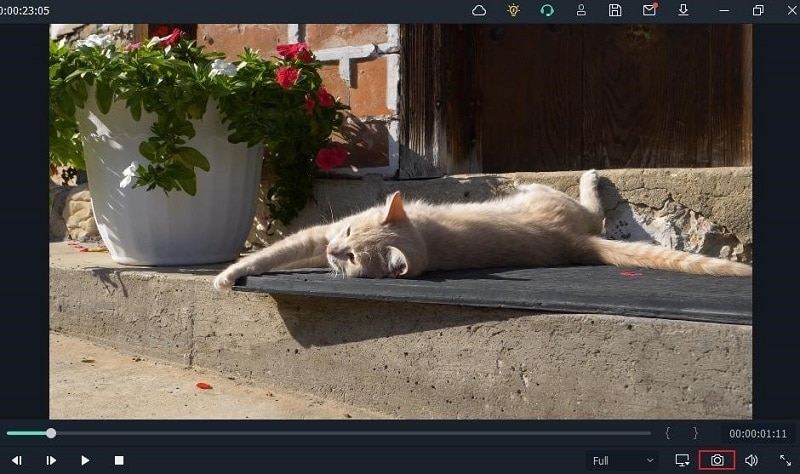
Platform: Windows/Mac
Price: Free Trial
Features
- 4k editing support enables users to edit and export videos at a resolution of up to 4k.
- scene detection
- audio equalizer
- GIF stabilization
Pros
- Easy to use, very intuitive interface.
- Plenty of effects and presets. Useful for less experienced people.
- Very many online resources, tutorials, preset packs, effects, etc.
- Outstanding and responsive support. In live chats always polite and professional.
- It is constantly updated.
Cons
- 4K editing sucks sometines
2. Movavi
Movavi Video Editor is a pioneer in the video editing industry due to its simplicity of use and dependable video editing capabilities. This software, available for both Windows and Mac OS, has quickly become a popular favorite. It is one of the best MP4-to-GIF converters because of its speed and reliability. It will let you produce GIFs from your movies in no time.
This program’s ability to batch export files is one of its best features, making producing and converting many GIFs simpler. Therefore, it is the most practical for frequent GIF makers, whether for personal or professional usage.
Though you may need to buy Movavi to get all of these excellent features, a free trial version is available for those who want to check it out before buying. The trial version is also ideal for individuals who need to convert movies to GIFs once.
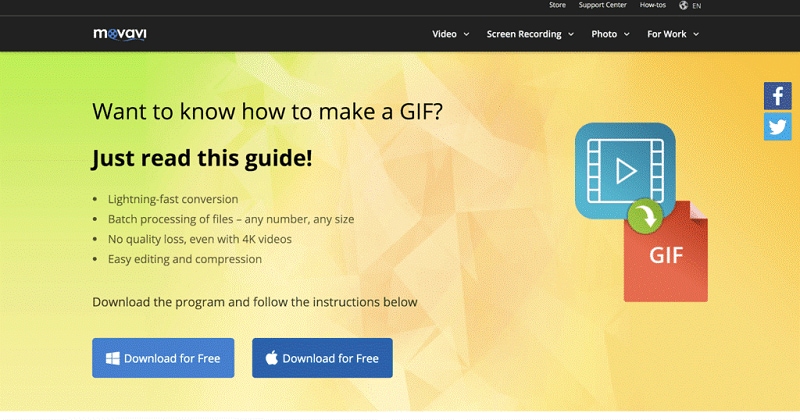
Platform: Windows/Mac
Price: $49.95/year for 1PC
Features
- Fast processing of 4K videos.
- Timeline markers.
- Keyframe animation.
- Built-in media pack.
- Automatic video creation.
Pros
- Has editing options
- Clear interface
- Supports many formats
Cons
- Only a trial version with limited period is free.
- It’s very basic
- No copy pasting options
3. Gifski
You can convert videos to GIFs using Gifski . Drop a file into the Gifski window or use the Open button to search your Mac for a video. The segment of the video you wish to transform into a GIF will be readily selected.
You may choose the size of your GIF, the frame rate, graphic quality, and how many times it loops using this Mac GIF creator. You can have it repeat indefinitely, and you can also make it bounce (this is where it plays to the end, then plays backward, then forward again, and so on).
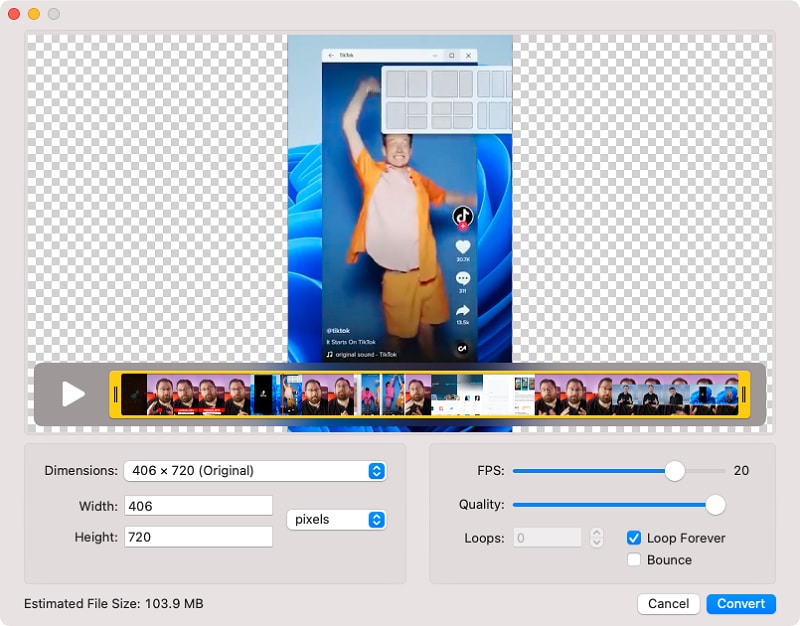
Platform: Mac
**Price:**Free
Features
- High-quality GIFs
- Command-based conversion
Pros
- Ihe software is safe to use.
- It support is good
Cons
- It doesn’t work offline
- Some users complain about the search function
4. Freemore
Freemore Video to GIF Converter is software that converts videos into animated GIFs, enabling you to pick the precise frames to include in the GIF and change the frame’s width and height if you have a unique use case.
This program is completely free and supports all of the most common video formats, including MP4, MPEG, MOV, FLV, etc. While this tool is free, it wasn’t necessarily created to be attractive; if you download Freemore, anticipate a more practical design that, while very functional, isn’t particularly pleasing to the eye.
Freemore Video to GIF Converter is only accessible for download on Windows, unfortunate for Mac users.

Platform: Windows/Mac
**Price:**Free
Features
- Convert video files to animated GIFs;
- Make GIFs for a website, mobile phone screensaver, signature, etc.
- Clip video to create GIF;
- Adjust the width and height to suit your needs;
- Support all key video formats.
Pros
- Support multi-core CPU
- Less burden on your system
- Abundant guide content & online support
- Free, safe & no restrictions
Cons
- The maximum input video size is 10 MB
- It might be unstable on a new OS like Windows 10
5. GIF Brewery by Gfycat
Look no farther than GIF Brewery by Gfycat for Mac users searching for a simple video to GIF converter tool.
You may begin by importing a movie, producing a screen recording, or recording straight from your camera using GIF Brewery. You may then customize your GIF by scaling the video, changing the frame rate, and adding filters and overlays to give it a unique style.
Finally, save your GIF to your computer or send it to someone else using iMessage or Mail. The app gets excellent reviews in the app store and is free to download.
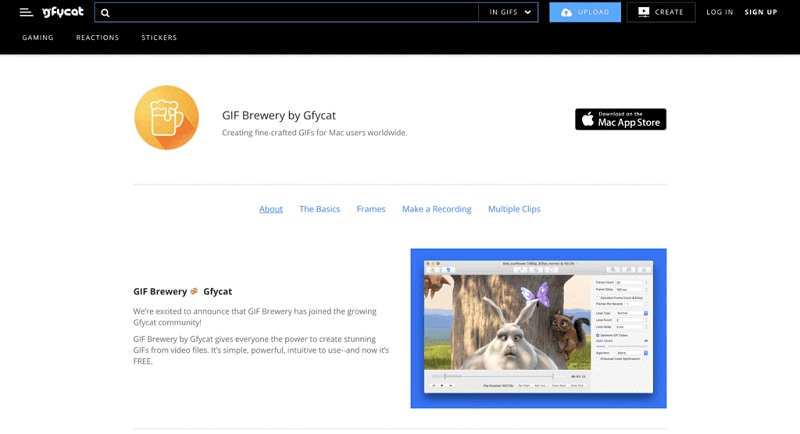
**Platform:**Mac
**Price:**Free
Features
- It gives everyone the power to create stunning GIFs from video files.
- It’s simple yet powerful.
Pros
- The GIF Brewery design is good.
- The performance of GIF Brewery is good.
- he GIF Brewery is compatible with lots of devices.
- The support of GIF Brewery is excellent and useful.
- The price of GIF Brewery is free or perhaps freemium.
Cons
- GIF Brewery 3 by Gfycat Reduce battery consumption
- Loads very slowly
6. Any GIF Animator
Any GIF converter app’s simple and powerful design can instantly convert your favorite movies into interactive GIFs. It can play a variety of file types, including WEBM, ASF, MPG, FLV, and AVI. The greatest aspect is that this program also enables users to import media files from optical storage devices such as DVDs and even analyze camera-captured displays. Users may easily select frame rate start and finish time markers, and complex text overlays, loops, and resolution effects are available for customization.

**Platform:**Windows/Mac
**Price:**free with ads
Features
- Its simple and intuitive layout allows you to operate it without consulting the user manual.
- It’s straightforward and hassle-free.
- With the aid of an animation wizard, you can polish your GIF animation. It’s a simple and fast approach to customizing and enhancing your GIF animation.
- You receive a built-in picture editor with a full collection of editing capabilities.
- On Any GIF Animator, you may convert video to gif in various visual formats. PNG, JPEG, TIFF, BMP, GIF, ICO, PSD, PCX, RLE, PIC, DIB, AVI, PCD, WMF, and more formats are included.
Pros
- Easy to install
- Neat interface
- Clips can be edited
- Accepts any video file
Cons
- Sometimes crashes
- Cannot animate photos
- Upload time takes long
- Converting takes long
7. KickMyGraphics
Here’s a simple yet effective GIF converter that can record, generate, and manipulate GIF pictures to deliver high-quality customized output. Users may effortlessly upload animated clips in common file formats such as PNG, BMP, JPG, ordinary GIF, and animated GIF to this site. Users may simply change the output file format, size, and quality parameters. Rotate, trim, stretch, loopback, scale, and many more options are available in the advanced editor.

**Platform:**Windows/Mac
**Price:**Free
Features
- It’s a little piece of shareware that converts video to gif.
- You may also import video files in MPG, AVI, MP4, ASF, etc. Animated Gif, Jpg, Bmp, and Png
- files may all be imported.
- Animated GIF pictures may be recorded directly.
- Loop, stretch, pan, reverse, and many more editing options are available.
Pros
- Offers 90 degree image rotation facility.
- Comes with professional level settings.
- Allows users to create an animated GIF from local images.
Cons
- It is complicated for beginners.
- Support limited file formats.
- Has limited functions.
8. Instagiffer
Instagiffer allows users to quickly grab memorable stills from their screens and then process them interactively to create GIFs. Instagiffer can let you import any of your chosen moments for making GIFs, whether they are from your favorite YouTube video, a cute Vine start, or anything amusing from Netflix. This fast professional picture editing application’s loops, filters, and text capabilities are extensive. It is completely free, and there are no viruses, malware, or irritating advertisements on our platform.
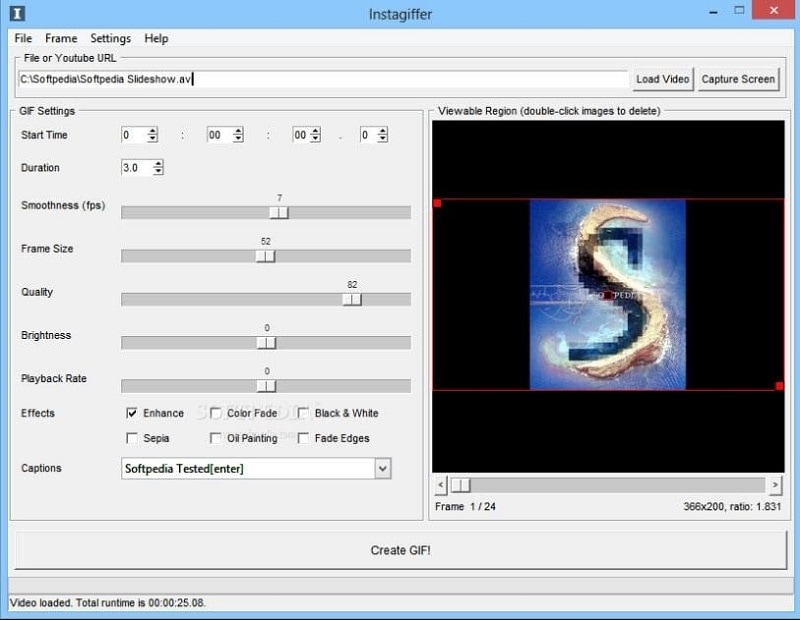
**Platform:**Windows/Mac
**Price:**Free
Features
- You can immediately record the most GIF-worthy moments on your screen.
- Text, filters, loops, and more may be added.
- Completely free video to gif conversion.
- Text and unique logos may be added quickly and easily.
- There will be no watermarks on your gifs if you use Instagriffer.
Pros
- Can make 3D GIFs
- Has a portable version
- The Instagiffer software is safe to use
Cons
- On the Instagriffer website, finding a suitable software installation is tough.
- The program may seem difficult to a novice.
- Its interface is outdated.
9. Microsoft GIF Animator
It is a prominent Microsoft product . This is a free version that you can get from the Microsoft shop. It may be used with Windows 10. You must first sign in with your Microsoft account to download this program. It offers a straightforward user interface with clear controls. You must upload the necessary amount of photographs in file types such as.JPEG,.bmp,.bpg,.png, etc. Set the settings for frame delay, frame count, and so forth. Finally, use the ‘Create’ button to create your GIF animation. Following your selected GIF animation preview, you may download the file.
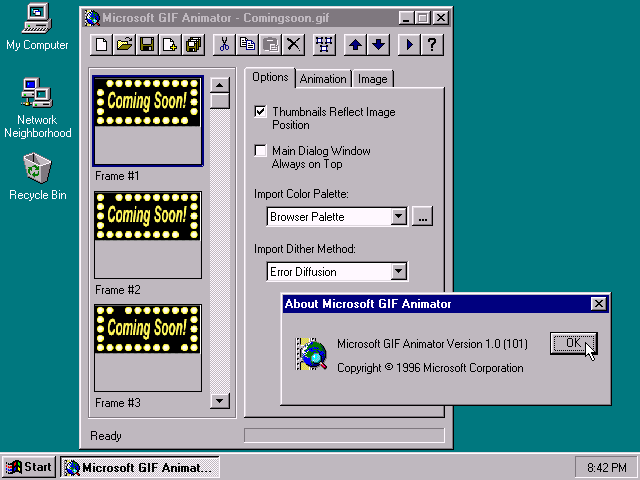
**Platform:**Windows
Price:$60.00 one-time payment
FeaturesFree
- Upload numerous photos into the GIF list box quickly.
- The photographs are quickly assembled into GIF frames as animation with a single click of the ‘Create’ button.
- Set the frame interval to suit your requirements.
Pros
- The free version is enough for creating high-quality GIF animations.
- The findings are simple to utilize on social networking platforms.
- Cost-effective.
Cons
- There are just a few choices for customizing GIF pictures.
- Only suitable for beginners.
- Internet speed can affect how the GIF is played.
10. VideoSolo Video to GIF Converter
When producing animations, VideoSolo video-to-GIF converter program offers several possibilities. It contains features for trimming videos, selecting certain portions of films, and joining bits of several videos to create a GIF file. It contains an integrated video editor that allows you to make changes to your final result. To make your GIF more appealing, you may trim, modify contrast and saturation, and change the video color, among other things. This movie-to-GIF program comes with the bonus of allowing you to add a photo overlay or text to your GIF to make it even more enjoyable. If you’re unhappy with the picture quality or frame rate, you may change them to suit your needs.

**Platform:**Windows/Mac
**Price:**Free
Features
- Make professional-looking GIFs with no technical knowledge.
- Supports almost all video formats going.
- Create cool avatars for games.
Pros
- Several editing options
- Not very resource-intensive
- Supports multiple video formats
Cons
- Some aspects may be difficult to locate.
- The Mac version receives fewer updates than the Windows version.
- You need to download it on your computer.
11. Movie to GIF

**Platform:**Windows
**Price:**Free/Premium($49.99/mo)
Features
- Convert video to GIF with ease.
- GIF files may be used to play video snippets.
- Increase the frame rate to make the output GIF look like the source video.
- The GIF’s width and height may be changed. An easy-to-use UI.
Pros
- Easy to use.
- Convert videos in batch code.
- Multilingual interface including English, Japanese, Spanish, etc.
- Fast conversion rate.
- HD output quality.
Cons
- Windows version only
- It’s time consuming
- The premium version is very expensive
12 Best Video To GIF Converter Online
2. Ezgif-F
This application is a free GIF animator that may be used in an online mode without any registration. Windows and web browsers are both supported. Choose the ‘GIF Maker’ option on the official website and upload the photographs by hitting the ‘Choose files’ button. You may effortlessly upload many photographs in any format. To produce a high-quality GIF animation, hit the ‘Upload and Create a GIF’ option once you’ve finished uploading.
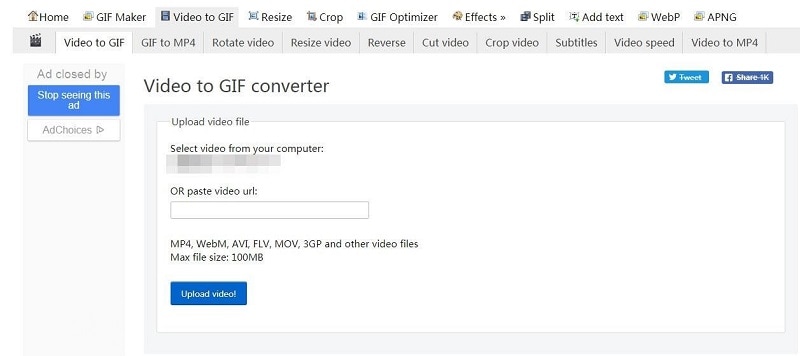
**Price:**Free
Features
- Up to 2000 picture files may be uploaded.
- GIF, PNG, JPEG, APNG, MNG, WebP, and other image file types are all supported.
- Allows you to submit a zip file of photos.
- You have complete control over frame speed.
Pros
- Multiple picture files may be uploaded at once.
- Automate settings to reduce the size of all images in the picture list to the shortest dimension.
- There is no need to pay a subscription fee.
Cons
- When there are a large number of photos in the list, this program takes a long time to make GIF animation.
- Advertisements sometimes disrupt the operation.
3. Adobe
Adobe is a world leading video to GIF converter and other marketing solutions. Everyone – from young artists to big companies – can use our creative, marketing, and document solutions to bring digital ideas to life and deliver comprehensive, compelling GIFs to the right spot at the right time for the best outcomes.

**Price:**Free
Features
- Offers support for raster graphics
- Rich text
- Audio-video embedding
Pros
- The adaptability of what Adobe Animate can do makes it so helpful.
- Utilizing Adobe Animate recordings on sites is typical, so individuals are accustomed to seeing it and have the essential modules introduced.
- The GIFs are little, and is extremely smooth.
Cons
- Cumbersome interface
- Outdated technology
- Limited capabilities
4. Cloudconvert
Online cloudconvert converts your mp4 media files to GIF. Cloudconvert supports a wide range of music, video, document, ebook, archive, image, spreadsheet, and presentation formats, including mp4, webm, and AVI. The video resolution, quality, and file size can all be customized. No software needs to be downloaded or installed.
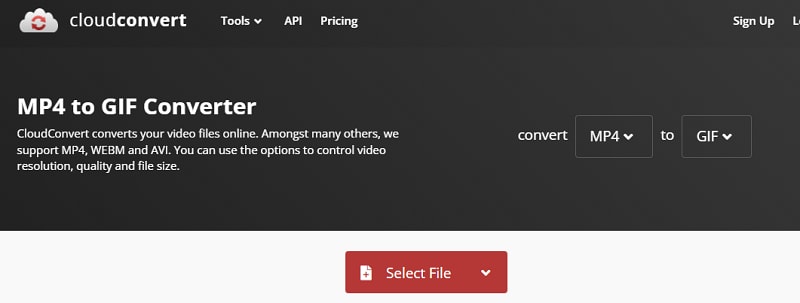
**Price:**Free
Features
- It can adapt 256 colors and uses a lossless compression technique to contain images.
- It can also contain texts.
- It can contain low sized image animation. So it is frequently used in web publishing.
Pros
- One can set preset properties for the file conversion
- Saves you time and can convert files into the format you are looking for
- Very good price
Cons
- It is confusing in the beginning for the interface and knowing which button to press
- Limits you to your bandwidth, so it is complicated to convert big files because sometimes it throws a timeout error.
5. Vistacreate
When you need to convert video files into elevated animated GIFs, VistaCreate is the tool to use. You can trim the video file, specify the desired GIF size (Original, 800px), choose a video processing method, and GIF length dependent on the frame rate you choose, much like with Ezgif. Even though the maximum file size is limited to 50MB, MP4, WebM, AVI, MPEG, FLV, MOV, and 3GP are all acceptable formats.
If you have a transparent video, don’t worry; the transparency will be preserved in the final animated GIF. Keep in mind that the converted GIF must be downloaded as soon as possible before it is erased from the server.
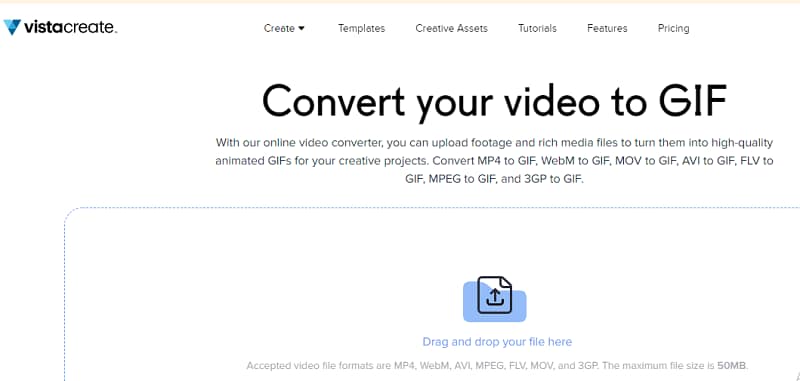
**Price:**Free
Features
- Video splitter and joiner
Pros
- It allows you to convert videos into GIFs for use on social media, web design, marketing, or blogging.
- It presents a GIF editor tool to help you refine the GIF further.
- It allows you to create both long and short GIFs.
- It boasts flexibility in look, conversion speed, and quality of the output GIF.
Cons
- The templates, icons, animations and stock imagery that come with Crello are impressive.
- They create an impact and attract a lot of comments and engagement when posted.
- The quality and range of posts and videos I can create using their templates have improved my engagement and really stand out.
6. Online Converter
Create animated GIFs from movies and photos using thisfree online tool . It can convert photos to GIFs in addition to being a video converter. It can play a variety of video and picture formats, including mp4, .m4b,.m4v, and.mkv. The converter, however, does not handle picture files that are protected and/or encrypted.

**Price:**Free
Features
- It can convert PDF files to GIF images.
- Converting RAW picture files to GIF is supported.
Pros
- Conveys messages better.
- Small file size.
- Conveys messages better.
Cons
- Internet connection matters.
- Editing is not possible.
- Limited color pattern.
7. GIPHY
Giphy is the most popular online GIF site, with millions of people visiting it every day. It is well-liked since it is simple to use. Before selecting “create,” you enter your video URL into the window’s appropriate area. Simple tools, such as drag-and-drop options for importing films and photographs from your local storage, are also available on this site.
This site, unlike several others, enables you to add sound clips to GIFs, making them more intriguing than their muted equivalents. You can also use tags and descriptions to make your GIFs more appealing.

**Price:**Free
Features
- Intuitive web interface
- Add sound to GIF
- Create 3d GIFs
Pros
- Supports sounds
- Easy to use
Cons
- It is not available offline.
- Some people are unhappy with the search feature.
8. IMG2GO
This online file converter provides comprehensive options for altering the quality and look of animated GIFs. This free online program allows you to make animated GIFS from any video clip, including MP4, AVI, and WEBM. Additional functions include resizing, picture reduction, photo editing, and more.

**Price:**Free
Features
- SSL encryption protects files and servers. As a result, emailing your data is completely secure.
- It can play 3GP, AVI, FLV, MOV, MP4, WebM, and WMV files.
- It allows you to apply filter changes, pixel scaling, and DPI.
Pros
- Modern interface
- Quick video and image to GIF conversion
- No loss in quality
Cons
- Loaded with tons of ads
- Not many flexible options
- Adds unnecessary black border to the GIFs
9. MakeAGIF
MakeAGIF isn’t simply a video to GIF converter; it can convert almost anything to GIF. You may upload a video, record a video, paste a video link, or even submit a collection of photographs to create your own GIF on this simple website.
Then you may customize the output by adding stickers and captions, changing the GIF’s pace, and choosing a start and end time. The one drawback to this video to GIF converter is that each GIF has a MakeAGIF watermark; to remove the company’s branding from your clip, you’ll need to pay to the premium version, which costs $11.95 per month.

Price:$11.95/mo
Features
- Powerful GIF editing features like speed, framerate, and resolution
Pros
- Easy to use
- You can customize output to your liking
Cons
- Free version has watermarks
- It does not give the best quality output
10.Convertio
One of the easiest programs on our list isConvertio . To convert a video to a GIF, just drag it onto the tool or upload it from your Google Drive or Dropbox account, then click “convert” to finish the process.
Use this tool just if you don’t care about details. Convertio is simple to use, however you can’t set the start and finish of your GIF or the frame rate.

**Price:**Free
Features
- Share files to Drive, DropBox
- Edit FPS
Pros
- Ability to pick source footage from hard disk, Dropbox, Google Drive, or URL.
- Integrates Google Drive and Dropbox services
- Supports batch processing
- Offers an API to app developers
- Safe and secure online tool
- Fast and easy to use
Cons
- Converts a file of only up to 100 MB (for unregistered free users).
11. HNET
Virtually any video (mp4, flv, mpeg, webm, mov, avi, 3gp, etc.) may be converted to animated GIF format withthis online tool . Your video to gif conversion takes place in the cloud, so it won’t take up any of your computer or phone’s resources. This implies it runs on all major operating systems. After one hour, all of the files you submitted and converted will be permanently erased from the server. Your files are private; no one else may see or download them except you.
You may post your GIF picture on imgur, Pinterest, Reddit, Tumblr, 4chan, Deviantart, Flickr, and other popular image sharing sites once your video clip has been converted to GIF format.
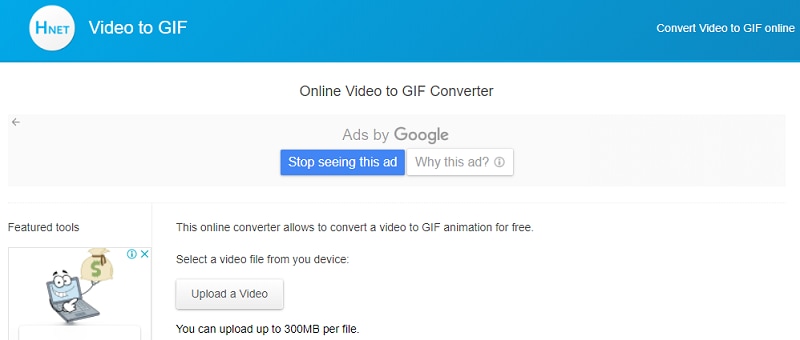
**Price:**Free
Features
- Supports all OS
- File sharing after conversion
- Support many file formats
Pros
- Very easy to use
- Free version comes with handy features
Cons
- It has a file size limit
- Your will be deleted after an hour in case you want to retrieve it.
12. ImgFlip
Imgflip GIF Maker is a simple, fast video to GIF converter that converts mp4 files into animated GIFs. You can turn your clip into a GIF using the Imgflip editor and tinker with parameters like frame rate, size, and more. Because of its sharing features, Imgflip truly shines. You may share your GIF on Facebook, Pinterest, Twitter, Tumblr, and other social media sites by downloading the file, copying the file link, or using the HTML5 image format code. Imgflip is a great alternative to consider if you need to get your GIFs out there quickly.

**Price:**Free
Features
- Video editor
- File sharing
- Parameter control
Pros
- Simple and lightweight
- Fast and accurate conversion
Cons
- I glitches when the file size is big
5 Best Video To GIF Converter for iPhone/iPad/Android Phone
1. GIF Maker - Video to GIF, GIF Editor
The comprehensive GIF generator for your Android smartphone is the final app on our list. It’s a great tool for editing all sorts of GIF pictures on your phone, as the name suggests. Although it lacks preset settings like filters and music, it gives everything needed to edit films to their full potential. Any picture or video may be converted and edited.

Platform: Android
**Price:**Free
Features
- Add filters and effects to GIFs
Pros
- The UI is simple to use.
- Editing capabilities are extensive.
Cons
- There are no filters available.
- There are no options for adding music or text to your GIF pictures.
2. Videos & GIF maker
This software provides everything you need to make humorous memes and animated GIFs on your iPhone phone. As the tool’s name suggests, you may easily add captions to your photos. You may also choose the output format for the GIF picture and the movie and the start and finish lengths.

**Platform:**iPhone
**Price:**free
Features
- Select the output format of your GIF
Pros
- The most user-friendly UI.
- The GIF graphics and memes are simple to make.
- Even on older devices, it does not crash and runs well.
- Instagram has many options for creating and sharing square photographs.
Cons
- There are no editing options for GIF pictures.
- There were some issues with posting images to social networking sites.
3. Gif Maker
You should install this application if you want an all-in-one freeGIF maker for your Android phone. In the programs, many attractive effects can be applied with a single click and modify the entire appearance of your images. Additionally, you may utilize the application’s camera to capture movies directly from the app. The nicest thing about this program is that it supports many languages and allows you to generate GIF images with 50 photographs.

**Platform:**Android
**Price:**Free
Features
- Concert up to 50 photos
- Convert real-time videos from the camera
Pros
- Free applications with a lot of functionality.
- It is available in many languages.
- Have a variety of picture effects to use.
Cons
- On certain devices, the app slows and crashes.
- Problems with sharing and uploading photographs with others.
4. Live GIF
This program converts live photos to GIF images on your iPhone. There are no difficult settings to worry about; all you have to do is upload the photographs to the app and make minor adjustments. The finished photographs may be downloaded or shared on social media sites like Facebook and Twitter.

**Platform:**iPhone
**Price:**Free
Features
- Share your GIFs on social media
Pros
- An easy-to-use UI.
- The iPhone 6S and 6S Plus have full 3D Touch capability.
- Sharing images on Twitter and Facebook is simple.
- There are no advertisements in the application.
Cons
- The price is a bit more than the features it offers.
- GIF pictures have no options for changing their resolution.
- There are no possibilities for adding text or music to GIF pictures.
5. Gift
Gift is another iPhone software that effortlessly converts photographs and movies to GIF images. Although this program does not convert Live Images, it is a solid alternative for converting regular photos and movies on older iPhone versions. According to the makers, the program is free to use and has several packages to add different effects and text to your photographs; however, most of the effects are only available in the premium version, which costs money. You may also share GIF pictures from the app on social media sites like Facebook, Twitter, Instagram, and Tumblr.

**Platform:**iPhone
**Price:**Free Version
Features
- Add text to GIFs
- Several effects available
Pros
- Basic editing is free to use.
- It is simple to use and does not need an internet connection.
- Over 70 effects to personalize your images and videos.
- The GIF picture may be saved to your iPhone.
Cons
- The finished GIF picture has a watermark.
- There are no video editing options available.
- Too expensive for the things it offers.
How to Convert a Video to GIF by Using Filmora
Step1Download, Launch and Import Media File to Filmora
To enter the interface, click New Project and then Import Media Files Here. Then drag and drop or add it straight to the window. You may also take a screenshot of the video and extract the shots or frames from it. The recovered photographs will appear in the media library, where you may add numerous video clips.

Step2Edit Video Based on Your Preference and Add Pictures (Optional)
To begin, drag & drop your video clip into the Timeline. Before choosing Export, you may trim, apply an effect, add a subtitle, and other features to the video. To convert the movie to GIF, click the Export option once everything is in order.

Step3Save and Export GIF
After hitting the Export option, a new window will appear where you may choose your export format. Choose GIF as your preferred format. When you’re through editing, click the Export option to save your work as a.gif file.
Note: A Setting button underneath the Resolution allows you to change the file resolution, frame rate, and bit rate.

Notice and Tips When Converting Video to GIF
Choosing software to save a video as a GIF
All operating systems have a way to convert video to GIF, as you can see in this article. All you have to do now is choose the right one. In a nutshell, here’s how you choose the right platform for your GIFs:
**Usability:**The video to GIF platform you use should be simple to use. You want a high-performance converter that’s also simple to use.
Tools: The platform should have all of the tools you’ll need to make an intriguing GIF, such as speed modification, filters, subtitles, and more.
Quality: To avoid pixelation, your platform must be able to make GIFs with a high resolution.
**Speed:**Because you don’t want to waste time waiting for your file to save, the speed at which the video converts to GIF is also significant.
Bottom Line
GIF files are efficient when played in browsers and provide good visual quality. GIFs are now often used to show How-To instructions and post memes on social media sites such as Facebook.
However, a quality video to GIF converter is a must-have tool. You can obtain more control over the source material and the created outputs using professional software rather than free web services. Download Wondershare Filmora today to enjoy the handy video to GIF conversion features that will give you the best experience.
- Media.io
- Ezgif-F
- Adobe
- Cloudconvert
- Vistacreate
- Online Converter
- GIPHY
- IMG2GO
- MakeAGIF
- Convertio
- HNET
- ImgFlip
- 5 Best Video To GIF Converter for iPhone/iPad/Android Phone
What’s the Difference Between a Video and a GIF?
GIFs are very popular among digital marketers (and anybody who uses the internet). These little bursts of repeating material may breathe new life into otherwise dull blog posts, emails, web pages, infographics, and other documents. Isn’t it thrilling?
While GIFs and videos may seem identical, the two forms of media are highly distinct, and the differences begin when the file types are first gathered.
GIFs are basically soundless picture collections that have been modified to resemble a video. On the other hand, videos are gathered as a kind of rich media that includes both motion and sound. What’s more, the viewing experiences for these two file kinds are somewhat different.
But why would someone want to convert a video to a GIF, to begin with? There are several explanations for this
GIFs are inexpensive
When converting a video to a GIF, you’re repurposing existing material to create something new. Why not get the most out of your video marketing strategy?
GIFs are simple to create
You don’t need to be a video expert in producing a GIF. Creating a GIF using one of the video-to-GIF converters listed below may take a few minutes.
GIFs are simple to use
GIFs offer motion and excitement to digital information without needing the viewer to devote a significant amount of time and attention - a significant advantage given the typical human attention span of roughly 8 seconds.
GIFs are effective
When Dell executed a GIF-centric marketing campaign, it experienced a 109 percent boost in sales, indicating that consumers appreciate (and react to) this basic but fascinating medium. Check out these video-to-GIF converters below to pick the best one for you.
14 Best Video Splitter for Windows/Mac
1. Filmora
You may quickly create a classic GIF picture as an output using Wondershare Filmora’s interactive platform. All common video file types, such as MKV, WMV, AVI, and MP4, are supported. The greatest thing is that Filmora does not impose any file size restrictions during conversion so that users may convert HD films to GIF graphics.
It’s a powerful image editor with many appealing features that allow you to personalize your picture completely. To create original GIFs, feel free to use complex components, animations, text, overlays, and so on.
In addition, Filmora enables you to extract still photos from videos of the same resolution. The retrieved PNG pictures may be combined and edited to create an intriguing GIF.

Platform: Windows/Mac
Price: Free Trial
Features
- 4k editing support enables users to edit and export videos at a resolution of up to 4k.
- scene detection
- audio equalizer
- GIF stabilization
Pros
- Easy to use, very intuitive interface.
- Plenty of effects and presets. Useful for less experienced people.
- Very many online resources, tutorials, preset packs, effects, etc.
- Outstanding and responsive support. In live chats always polite and professional.
- It is constantly updated.
Cons
- 4K editing sucks sometines
2. Movavi
Movavi Video Editor is a pioneer in the video editing industry due to its simplicity of use and dependable video editing capabilities. This software, available for both Windows and Mac OS, has quickly become a popular favorite. It is one of the best MP4-to-GIF converters because of its speed and reliability. It will let you produce GIFs from your movies in no time.
This program’s ability to batch export files is one of its best features, making producing and converting many GIFs simpler. Therefore, it is the most practical for frequent GIF makers, whether for personal or professional usage.
Though you may need to buy Movavi to get all of these excellent features, a free trial version is available for those who want to check it out before buying. The trial version is also ideal for individuals who need to convert movies to GIFs once.

Platform: Windows/Mac
Price: $49.95/year for 1PC
Features
- Fast processing of 4K videos.
- Timeline markers.
- Keyframe animation.
- Built-in media pack.
- Automatic video creation.
Pros
- Has editing options
- Clear interface
- Supports many formats
Cons
- Only a trial version with limited period is free.
- It’s very basic
- No copy pasting options
3. Gifski
You can convert videos to GIFs using Gifski . Drop a file into the Gifski window or use the Open button to search your Mac for a video. The segment of the video you wish to transform into a GIF will be readily selected.
You may choose the size of your GIF, the frame rate, graphic quality, and how many times it loops using this Mac GIF creator. You can have it repeat indefinitely, and you can also make it bounce (this is where it plays to the end, then plays backward, then forward again, and so on).

Platform: Mac
**Price:**Free
Features
- High-quality GIFs
- Command-based conversion
Pros
- Ihe software is safe to use.
- It support is good
Cons
- It doesn’t work offline
- Some users complain about the search function
4. Freemore
Freemore Video to GIF Converter is software that converts videos into animated GIFs, enabling you to pick the precise frames to include in the GIF and change the frame’s width and height if you have a unique use case.
This program is completely free and supports all of the most common video formats, including MP4, MPEG, MOV, FLV, etc. While this tool is free, it wasn’t necessarily created to be attractive; if you download Freemore, anticipate a more practical design that, while very functional, isn’t particularly pleasing to the eye.
Freemore Video to GIF Converter is only accessible for download on Windows, unfortunate for Mac users.

Platform: Windows/Mac
**Price:**Free
Features
- Convert video files to animated GIFs;
- Make GIFs for a website, mobile phone screensaver, signature, etc.
- Clip video to create GIF;
- Adjust the width and height to suit your needs;
- Support all key video formats.
Pros
- Support multi-core CPU
- Less burden on your system
- Abundant guide content & online support
- Free, safe & no restrictions
Cons
- The maximum input video size is 10 MB
- It might be unstable on a new OS like Windows 10
5. GIF Brewery by Gfycat
Look no farther than GIF Brewery by Gfycat for Mac users searching for a simple video to GIF converter tool.
You may begin by importing a movie, producing a screen recording, or recording straight from your camera using GIF Brewery. You may then customize your GIF by scaling the video, changing the frame rate, and adding filters and overlays to give it a unique style.
Finally, save your GIF to your computer or send it to someone else using iMessage or Mail. The app gets excellent reviews in the app store and is free to download.

**Platform:**Mac
**Price:**Free
Features
- It gives everyone the power to create stunning GIFs from video files.
- It’s simple yet powerful.
Pros
- The GIF Brewery design is good.
- The performance of GIF Brewery is good.
- he GIF Brewery is compatible with lots of devices.
- The support of GIF Brewery is excellent and useful.
- The price of GIF Brewery is free or perhaps freemium.
Cons
- GIF Brewery 3 by Gfycat Reduce battery consumption
- Loads very slowly
6. Any GIF Animator
Any GIF converter app’s simple and powerful design can instantly convert your favorite movies into interactive GIFs. It can play a variety of file types, including WEBM, ASF, MPG, FLV, and AVI. The greatest aspect is that this program also enables users to import media files from optical storage devices such as DVDs and even analyze camera-captured displays. Users may easily select frame rate start and finish time markers, and complex text overlays, loops, and resolution effects are available for customization.

**Platform:**Windows/Mac
**Price:**free with ads
Features
- Its simple and intuitive layout allows you to operate it without consulting the user manual.
- It’s straightforward and hassle-free.
- With the aid of an animation wizard, you can polish your GIF animation. It’s a simple and fast approach to customizing and enhancing your GIF animation.
- You receive a built-in picture editor with a full collection of editing capabilities.
- On Any GIF Animator, you may convert video to gif in various visual formats. PNG, JPEG, TIFF, BMP, GIF, ICO, PSD, PCX, RLE, PIC, DIB, AVI, PCD, WMF, and more formats are included.
Pros
- Easy to install
- Neat interface
- Clips can be edited
- Accepts any video file
Cons
- Sometimes crashes
- Cannot animate photos
- Upload time takes long
- Converting takes long
7. KickMyGraphics
Here’s a simple yet effective GIF converter that can record, generate, and manipulate GIF pictures to deliver high-quality customized output. Users may effortlessly upload animated clips in common file formats such as PNG, BMP, JPG, ordinary GIF, and animated GIF to this site. Users may simply change the output file format, size, and quality parameters. Rotate, trim, stretch, loopback, scale, and many more options are available in the advanced editor.

**Platform:**Windows/Mac
**Price:**Free
Features
- It’s a little piece of shareware that converts video to gif.
- You may also import video files in MPG, AVI, MP4, ASF, etc. Animated Gif, Jpg, Bmp, and Png
- files may all be imported.
- Animated GIF pictures may be recorded directly.
- Loop, stretch, pan, reverse, and many more editing options are available.
Pros
- Offers 90 degree image rotation facility.
- Comes with professional level settings.
- Allows users to create an animated GIF from local images.
Cons
- It is complicated for beginners.
- Support limited file formats.
- Has limited functions.
8. Instagiffer
Instagiffer allows users to quickly grab memorable stills from their screens and then process them interactively to create GIFs. Instagiffer can let you import any of your chosen moments for making GIFs, whether they are from your favorite YouTube video, a cute Vine start, or anything amusing from Netflix. This fast professional picture editing application’s loops, filters, and text capabilities are extensive. It is completely free, and there are no viruses, malware, or irritating advertisements on our platform.

**Platform:**Windows/Mac
**Price:**Free
Features
- You can immediately record the most GIF-worthy moments on your screen.
- Text, filters, loops, and more may be added.
- Completely free video to gif conversion.
- Text and unique logos may be added quickly and easily.
- There will be no watermarks on your gifs if you use Instagriffer.
Pros
- Can make 3D GIFs
- Has a portable version
- The Instagiffer software is safe to use
Cons
- On the Instagriffer website, finding a suitable software installation is tough.
- The program may seem difficult to a novice.
- Its interface is outdated.
9. Microsoft GIF Animator
It is a prominent Microsoft product . This is a free version that you can get from the Microsoft shop. It may be used with Windows 10. You must first sign in with your Microsoft account to download this program. It offers a straightforward user interface with clear controls. You must upload the necessary amount of photographs in file types such as.JPEG,.bmp,.bpg,.png, etc. Set the settings for frame delay, frame count, and so forth. Finally, use the ‘Create’ button to create your GIF animation. Following your selected GIF animation preview, you may download the file.

**Platform:**Windows
Price:$60.00 one-time payment
FeaturesFree
- Upload numerous photos into the GIF list box quickly.
- The photographs are quickly assembled into GIF frames as animation with a single click of the ‘Create’ button.
- Set the frame interval to suit your requirements.
Pros
- The free version is enough for creating high-quality GIF animations.
- The findings are simple to utilize on social networking platforms.
- Cost-effective.
Cons
- There are just a few choices for customizing GIF pictures.
- Only suitable for beginners.
- Internet speed can affect how the GIF is played.
10. VideoSolo Video to GIF Converter
When producing animations, VideoSolo video-to-GIF converter program offers several possibilities. It contains features for trimming videos, selecting certain portions of films, and joining bits of several videos to create a GIF file. It contains an integrated video editor that allows you to make changes to your final result. To make your GIF more appealing, you may trim, modify contrast and saturation, and change the video color, among other things. This movie-to-GIF program comes with the bonus of allowing you to add a photo overlay or text to your GIF to make it even more enjoyable. If you’re unhappy with the picture quality or frame rate, you may change them to suit your needs.

**Platform:**Windows/Mac
**Price:**Free
Features
- Make professional-looking GIFs with no technical knowledge.
- Supports almost all video formats going.
- Create cool avatars for games.
Pros
- Several editing options
- Not very resource-intensive
- Supports multiple video formats
Cons
- Some aspects may be difficult to locate.
- The Mac version receives fewer updates than the Windows version.
- You need to download it on your computer.
11. Movie to GIF

**Platform:**Windows
**Price:**Free/Premium($49.99/mo)
Features
- Convert video to GIF with ease.
- GIF files may be used to play video snippets.
- Increase the frame rate to make the output GIF look like the source video.
- The GIF’s width and height may be changed. An easy-to-use UI.
Pros
- Easy to use.
- Convert videos in batch code.
- Multilingual interface including English, Japanese, Spanish, etc.
- Fast conversion rate.
- HD output quality.
Cons
- Windows version only
- It’s time consuming
- The premium version is very expensive
12 Best Video To GIF Converter Online
2. Ezgif-F
This application is a free GIF animator that may be used in an online mode without any registration. Windows and web browsers are both supported. Choose the ‘GIF Maker’ option on the official website and upload the photographs by hitting the ‘Choose files’ button. You may effortlessly upload many photographs in any format. To produce a high-quality GIF animation, hit the ‘Upload and Create a GIF’ option once you’ve finished uploading.

**Price:**Free
Features
- Up to 2000 picture files may be uploaded.
- GIF, PNG, JPEG, APNG, MNG, WebP, and other image file types are all supported.
- Allows you to submit a zip file of photos.
- You have complete control over frame speed.
Pros
- Multiple picture files may be uploaded at once.
- Automate settings to reduce the size of all images in the picture list to the shortest dimension.
- There is no need to pay a subscription fee.
Cons
- When there are a large number of photos in the list, this program takes a long time to make GIF animation.
- Advertisements sometimes disrupt the operation.
3. Adobe
Adobe is a world leading video to GIF converter and other marketing solutions. Everyone – from young artists to big companies – can use our creative, marketing, and document solutions to bring digital ideas to life and deliver comprehensive, compelling GIFs to the right spot at the right time for the best outcomes.

**Price:**Free
Features
- Offers support for raster graphics
- Rich text
- Audio-video embedding
Pros
- The adaptability of what Adobe Animate can do makes it so helpful.
- Utilizing Adobe Animate recordings on sites is typical, so individuals are accustomed to seeing it and have the essential modules introduced.
- The GIFs are little, and is extremely smooth.
Cons
- Cumbersome interface
- Outdated technology
- Limited capabilities
4. Cloudconvert
Online cloudconvert converts your mp4 media files to GIF. Cloudconvert supports a wide range of music, video, document, ebook, archive, image, spreadsheet, and presentation formats, including mp4, webm, and AVI. The video resolution, quality, and file size can all be customized. No software needs to be downloaded or installed.

**Price:**Free
Features
- It can adapt 256 colors and uses a lossless compression technique to contain images.
- It can also contain texts.
- It can contain low sized image animation. So it is frequently used in web publishing.
Pros
- One can set preset properties for the file conversion
- Saves you time and can convert files into the format you are looking for
- Very good price
Cons
- It is confusing in the beginning for the interface and knowing which button to press
- Limits you to your bandwidth, so it is complicated to convert big files because sometimes it throws a timeout error.
5. Vistacreate
When you need to convert video files into elevated animated GIFs, VistaCreate is the tool to use. You can trim the video file, specify the desired GIF size (Original, 800px), choose a video processing method, and GIF length dependent on the frame rate you choose, much like with Ezgif. Even though the maximum file size is limited to 50MB, MP4, WebM, AVI, MPEG, FLV, MOV, and 3GP are all acceptable formats.
If you have a transparent video, don’t worry; the transparency will be preserved in the final animated GIF. Keep in mind that the converted GIF must be downloaded as soon as possible before it is erased from the server.

**Price:**Free
Features
- Video splitter and joiner
Pros
- It allows you to convert videos into GIFs for use on social media, web design, marketing, or blogging.
- It presents a GIF editor tool to help you refine the GIF further.
- It allows you to create both long and short GIFs.
- It boasts flexibility in look, conversion speed, and quality of the output GIF.
Cons
- The templates, icons, animations and stock imagery that come with Crello are impressive.
- They create an impact and attract a lot of comments and engagement when posted.
- The quality and range of posts and videos I can create using their templates have improved my engagement and really stand out.
6. Online Converter
Create animated GIFs from movies and photos using thisfree online tool . It can convert photos to GIFs in addition to being a video converter. It can play a variety of video and picture formats, including mp4, .m4b,.m4v, and.mkv. The converter, however, does not handle picture files that are protected and/or encrypted.

**Price:**Free
Features
- It can convert PDF files to GIF images.
- Converting RAW picture files to GIF is supported.
Pros
- Conveys messages better.
- Small file size.
- Conveys messages better.
Cons
- Internet connection matters.
- Editing is not possible.
- Limited color pattern.
7. GIPHY
Giphy is the most popular online GIF site, with millions of people visiting it every day. It is well-liked since it is simple to use. Before selecting “create,” you enter your video URL into the window’s appropriate area. Simple tools, such as drag-and-drop options for importing films and photographs from your local storage, are also available on this site.
This site, unlike several others, enables you to add sound clips to GIFs, making them more intriguing than their muted equivalents. You can also use tags and descriptions to make your GIFs more appealing.

**Price:**Free
Features
- Intuitive web interface
- Add sound to GIF
- Create 3d GIFs
Pros
- Supports sounds
- Easy to use
Cons
- It is not available offline.
- Some people are unhappy with the search feature.
8. IMG2GO
This online file converter provides comprehensive options for altering the quality and look of animated GIFs. This free online program allows you to make animated GIFS from any video clip, including MP4, AVI, and WEBM. Additional functions include resizing, picture reduction, photo editing, and more.

**Price:**Free
Features
- SSL encryption protects files and servers. As a result, emailing your data is completely secure.
- It can play 3GP, AVI, FLV, MOV, MP4, WebM, and WMV files.
- It allows you to apply filter changes, pixel scaling, and DPI.
Pros
- Modern interface
- Quick video and image to GIF conversion
- No loss in quality
Cons
- Loaded with tons of ads
- Not many flexible options
- Adds unnecessary black border to the GIFs
9. MakeAGIF
MakeAGIF isn’t simply a video to GIF converter; it can convert almost anything to GIF. You may upload a video, record a video, paste a video link, or even submit a collection of photographs to create your own GIF on this simple website.
Then you may customize the output by adding stickers and captions, changing the GIF’s pace, and choosing a start and end time. The one drawback to this video to GIF converter is that each GIF has a MakeAGIF watermark; to remove the company’s branding from your clip, you’ll need to pay to the premium version, which costs $11.95 per month.

Price:$11.95/mo
Features
- Powerful GIF editing features like speed, framerate, and resolution
Pros
- Easy to use
- You can customize output to your liking
Cons
- Free version has watermarks
- It does not give the best quality output
10.Convertio
One of the easiest programs on our list isConvertio . To convert a video to a GIF, just drag it onto the tool or upload it from your Google Drive or Dropbox account, then click “convert” to finish the process.
Use this tool just if you don’t care about details. Convertio is simple to use, however you can’t set the start and finish of your GIF or the frame rate.

**Price:**Free
Features
- Share files to Drive, DropBox
- Edit FPS
Pros
- Ability to pick source footage from hard disk, Dropbox, Google Drive, or URL.
- Integrates Google Drive and Dropbox services
- Supports batch processing
- Offers an API to app developers
- Safe and secure online tool
- Fast and easy to use
Cons
- Converts a file of only up to 100 MB (for unregistered free users).
11. HNET
Virtually any video (mp4, flv, mpeg, webm, mov, avi, 3gp, etc.) may be converted to animated GIF format withthis online tool . Your video to gif conversion takes place in the cloud, so it won’t take up any of your computer or phone’s resources. This implies it runs on all major operating systems. After one hour, all of the files you submitted and converted will be permanently erased from the server. Your files are private; no one else may see or download them except you.
You may post your GIF picture on imgur, Pinterest, Reddit, Tumblr, 4chan, Deviantart, Flickr, and other popular image sharing sites once your video clip has been converted to GIF format.

**Price:**Free
Features
- Supports all OS
- File sharing after conversion
- Support many file formats
Pros
- Very easy to use
- Free version comes with handy features
Cons
- It has a file size limit
- Your will be deleted after an hour in case you want to retrieve it.
12. ImgFlip
Imgflip GIF Maker is a simple, fast video to GIF converter that converts mp4 files into animated GIFs. You can turn your clip into a GIF using the Imgflip editor and tinker with parameters like frame rate, size, and more. Because of its sharing features, Imgflip truly shines. You may share your GIF on Facebook, Pinterest, Twitter, Tumblr, and other social media sites by downloading the file, copying the file link, or using the HTML5 image format code. Imgflip is a great alternative to consider if you need to get your GIFs out there quickly.

**Price:**Free
Features
- Video editor
- File sharing
- Parameter control
Pros
- Simple and lightweight
- Fast and accurate conversion
Cons
- I glitches when the file size is big
5 Best Video To GIF Converter for iPhone/iPad/Android Phone
1. GIF Maker - Video to GIF, GIF Editor
The comprehensive GIF generator for your Android smartphone is the final app on our list. It’s a great tool for editing all sorts of GIF pictures on your phone, as the name suggests. Although it lacks preset settings like filters and music, it gives everything needed to edit films to their full potential. Any picture or video may be converted and edited.

Platform: Android
**Price:**Free
Features
- Add filters and effects to GIFs
Pros
- The UI is simple to use.
- Editing capabilities are extensive.
Cons
- There are no filters available.
- There are no options for adding music or text to your GIF pictures.
2. Videos & GIF maker
This software provides everything you need to make humorous memes and animated GIFs on your iPhone phone. As the tool’s name suggests, you may easily add captions to your photos. You may also choose the output format for the GIF picture and the movie and the start and finish lengths.

**Platform:**iPhone
**Price:**free
Features
- Select the output format of your GIF
Pros
- The most user-friendly UI.
- The GIF graphics and memes are simple to make.
- Even on older devices, it does not crash and runs well.
- Instagram has many options for creating and sharing square photographs.
Cons
- There are no editing options for GIF pictures.
- There were some issues with posting images to social networking sites.
3. Gif Maker
You should install this application if you want an all-in-one freeGIF maker for your Android phone. In the programs, many attractive effects can be applied with a single click and modify the entire appearance of your images. Additionally, you may utilize the application’s camera to capture movies directly from the app. The nicest thing about this program is that it supports many languages and allows you to generate GIF images with 50 photographs.

**Platform:**Android
**Price:**Free
Features
- Concert up to 50 photos
- Convert real-time videos from the camera
Pros
- Free applications with a lot of functionality.
- It is available in many languages.
- Have a variety of picture effects to use.
Cons
- On certain devices, the app slows and crashes.
- Problems with sharing and uploading photographs with others.
4. Live GIF
This program converts live photos to GIF images on your iPhone. There are no difficult settings to worry about; all you have to do is upload the photographs to the app and make minor adjustments. The finished photographs may be downloaded or shared on social media sites like Facebook and Twitter.

**Platform:**iPhone
**Price:**Free
Features
- Share your GIFs on social media
Pros
- An easy-to-use UI.
- The iPhone 6S and 6S Plus have full 3D Touch capability.
- Sharing images on Twitter and Facebook is simple.
- There are no advertisements in the application.
Cons
- The price is a bit more than the features it offers.
- GIF pictures have no options for changing their resolution.
- There are no possibilities for adding text or music to GIF pictures.
5. Gift
Gift is another iPhone software that effortlessly converts photographs and movies to GIF images. Although this program does not convert Live Images, it is a solid alternative for converting regular photos and movies on older iPhone versions. According to the makers, the program is free to use and has several packages to add different effects and text to your photographs; however, most of the effects are only available in the premium version, which costs money. You may also share GIF pictures from the app on social media sites like Facebook, Twitter, Instagram, and Tumblr.

**Platform:**iPhone
**Price:**Free Version
Features
- Add text to GIFs
- Several effects available
Pros
- Basic editing is free to use.
- It is simple to use and does not need an internet connection.
- Over 70 effects to personalize your images and videos.
- The GIF picture may be saved to your iPhone.
Cons
- The finished GIF picture has a watermark.
- There are no video editing options available.
- Too expensive for the things it offers.
How to Convert a Video to GIF by Using Filmora
Step1Download, Launch and Import Media File to Filmora
To enter the interface, click New Project and then Import Media Files Here. Then drag and drop or add it straight to the window. You may also take a screenshot of the video and extract the shots or frames from it. The recovered photographs will appear in the media library, where you may add numerous video clips.

Step2Edit Video Based on Your Preference and Add Pictures (Optional)
To begin, drag & drop your video clip into the Timeline. Before choosing Export, you may trim, apply an effect, add a subtitle, and other features to the video. To convert the movie to GIF, click the Export option once everything is in order.

Step3Save and Export GIF
After hitting the Export option, a new window will appear where you may choose your export format. Choose GIF as your preferred format. When you’re through editing, click the Export option to save your work as a.gif file.
Note: A Setting button underneath the Resolution allows you to change the file resolution, frame rate, and bit rate.

Notice and Tips When Converting Video to GIF
Choosing software to save a video as a GIF
All operating systems have a way to convert video to GIF, as you can see in this article. All you have to do now is choose the right one. In a nutshell, here’s how you choose the right platform for your GIFs:
**Usability:**The video to GIF platform you use should be simple to use. You want a high-performance converter that’s also simple to use.
Tools: The platform should have all of the tools you’ll need to make an intriguing GIF, such as speed modification, filters, subtitles, and more.
Quality: To avoid pixelation, your platform must be able to make GIFs with a high resolution.
**Speed:**Because you don’t want to waste time waiting for your file to save, the speed at which the video converts to GIF is also significant.
Bottom Line
GIF files are efficient when played in browsers and provide good visual quality. GIFs are now often used to show How-To instructions and post memes on social media sites such as Facebook.
However, a quality video to GIF converter is a must-have tool. You can obtain more control over the source material and the created outputs using professional software rather than free web services. Download Wondershare Filmora today to enjoy the handy video to GIF conversion features that will give you the best experience.
No Copyright Worries: 10 Top Public Domain Image Sites
10 Best Public Domain Image Websites

Liza Brown
Mar 27, 2024• Proven solutions
Finding an image you like on the Internet doesn’t take long, since almost every website you can stumble upon, contains at least one picture. This doesn’t mean that you can just download any photo and use it in your blog, online marketing campaign or for any other purpose. Moreover, stock image websites like Getty Images or iStock let you purchase the right to use a photo commercially. As a reaction to an expanding stock image industry, many photographers, museums and cultural institutions are choosing to forfeit their rights and to publish public domain images. So, in this article, we are going to take you through the ten best public domain image websites where you can download pictures for free.
What Are Public Domain Images?
By definition, public domain images are photos, vectors or clip art that are available to anyone because their copyright has either expired or they never had a copyright owner. Consequently, anyone can use these images for both commercial or private projects without having to purchase the rights to do so. An image can enter a public domain under the following circumstances:
- Scientists, educators or artists can use the Creative Commons Zero (CC0) license to dedicate their images to the public domain
- A picture’s copyright is no longer in effect
- A photo was never the subject to copyright
It is of utmost importance to check if an image is within the public domain before you use it publicly in order to avoid potential legal complications.
How and Where to Find Public Domain Images?
A simple google search will reveal hundreds of websites that let you download public domain and royalty-free images. Which source you’re going to use depends on the type of image you’re looking for, since some websites are dedicated only to photography, while others feature impressive collections of public domain images of artworks. In addition, you’ll only want to download public domain images from the websites that offer information about the author because using a public domain image without crediting its author is strictly prohibited.
Best Websites for Downloading Public Domain Images
We’ve searched the Internet and we utilized our results to compile a collection of the most reliable websites that grant its users access to vast numbers of public domain images. Let’s take a look at some of the best websites that let you download public domain images.
1. Pexels

Graphic designers and all other creatives in constant need of a fresh supply of public domain images don’t need a special introduction to Pexels. The stock image platform is dedicated to photography and video, so you can’t use it to search for vectors or clip art. Even so, you can use Pexles to search for public domain images based on a particular keyword or browse through its collection of free images and discover photos spontaneously. Clicking on the Popular Searches tab will enable you to see the images from Light, Nature or Animals and it will shorten the amount of time you have to spend looking for a photo you want to download.
Pros:
- Neatly organized website
- Free and easy sign-up
- Offers a huge selection of free public domain images and videos according to the CC0 license
- Hand-picked High quality Images
Cons:
- Some categories should contain more images
- Optimizing the search terms can be difficult
2. Pixabay
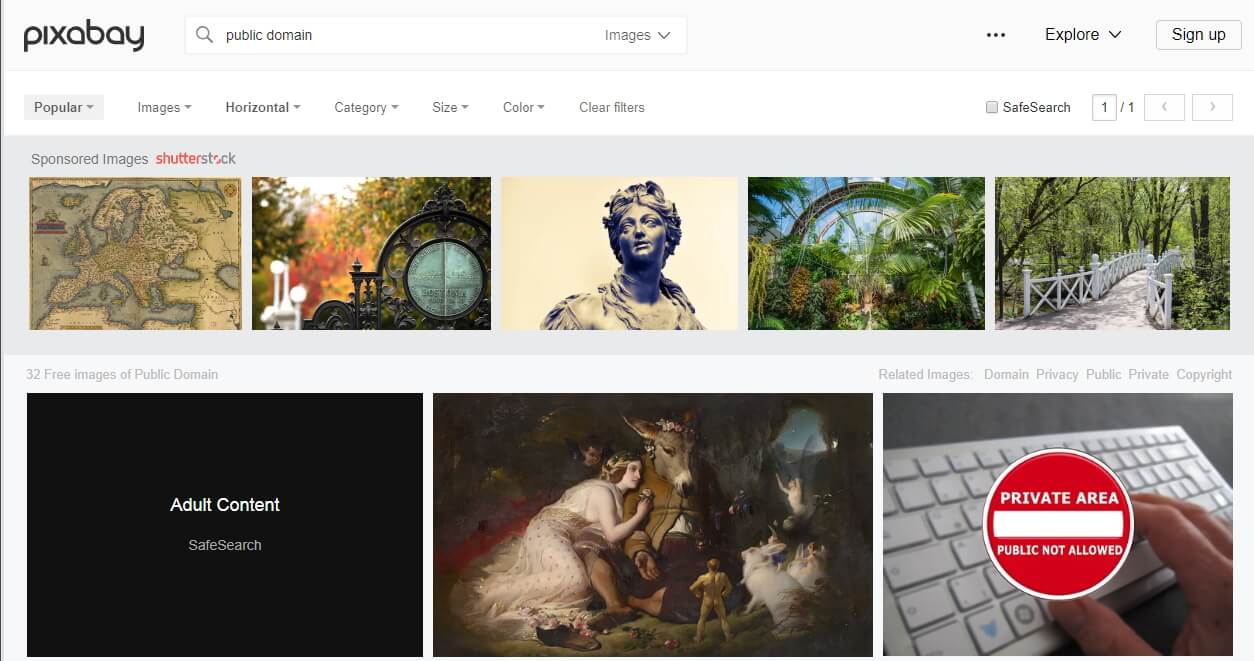
Besides offering an impressive collection of royalty-free photos, Pixabay also lets you search for public domain vectors, illustrations, and videos. The website hosts more than a million high-resolution photos and videos you can download for free. To make things even better, becoming a member of the Pixabay’s community and creating an account on this platform won’t take more than a few minutes of your time. Pixabay also offers advanced search tools that enable you to combine searches, search for the author of an image or group search terms. In addition, you can also browse through the photographers that contribute their images to the platform on a regular basis.
Pros:
- Powerful search tools and various filters
- Huge collection of public domain images
Cons
- Customer support could be better
3. Wikimedia Commons

This is probably the largest website on the Internet where you can download public domain images. There are more than 49 million images, illustrations, vector graphics and videos available that can be downloaded for free. Some media files on Wikimedia Commons have certain restrictions, but these restrictions are mostly related to image citations, which means that you can use them only if you credit the author. Such a huge selection of media files can be overwhelming for the newcomers to the Wikimedia Commons platform, but once you grow accustomed to the website’s interface discovering images becomes a straightforward process.
Pros:
- All images are available in high resolution
- Nearly all images can be used without any restrictions
Cons:
- Getting used to the website’s interface takes time
- The number of search results can be overwhelming
4. Flickr Commons

For more than a decade Flickr has been a popular online destination for photographers in need of a platform that enables them to present their work. The Flickr Commons is a project that unites more than a hundred institutions in an effort to create a library of public domain images. The project makes available a stunning amount of historical photographs and it grants you access to highly esteemed collections of photographs. Flick Commons is perfectly suited for researchers and scholars in need of public domain photos, they can use in their essays or research papers.
Pros:
- Unlimited access to historical photos
- Extends the knowledge available to the general public
Cons:
- Doesn’t offer videos or illustrations
- Search results are poorly organized
5. Unsplash

With a library that contains over 800,000 photos, Unsplash is easily one of the largest websites that offer public domain images. All pictures on this platform are organized into different categories, which makes finding a photo you want to use in a commercial or non-commercial project a relatively simple process. Alternatively, you can insert a keyword into a search bar and Unsplash will show you the results within seconds. However, the images you can find on this platform are similar to those you can purchase on stock photography websites, although some of them have an artistic touch that is hard to find on the majority of stock photos.
Pros:
- Excellent source of high-resolution photos
- Quick and easy search
Cons:
- Unsplash is dedicated solely to photography
- Limited amount of available public domain images
6. From Old Books
In case you are searching for images from old books you should look no further. This is a private collection of 2,600 images that are hard to find anywhere else on the Internet. You can browse through woodcuts, old texts or old holiday images, which makes this platform an excellent choice for anyone interested in rare images that were featured in old books. All pictures you can find on the From Old Books website are free to use on non-commercial projects, but you must pay a small fee if you want to download a high-resolution image you can use on a commercial project.
- Images are organized into categories
- Access to rare images
Cons
- Some images are not free
- Rudimentary website design
7. Morguefile
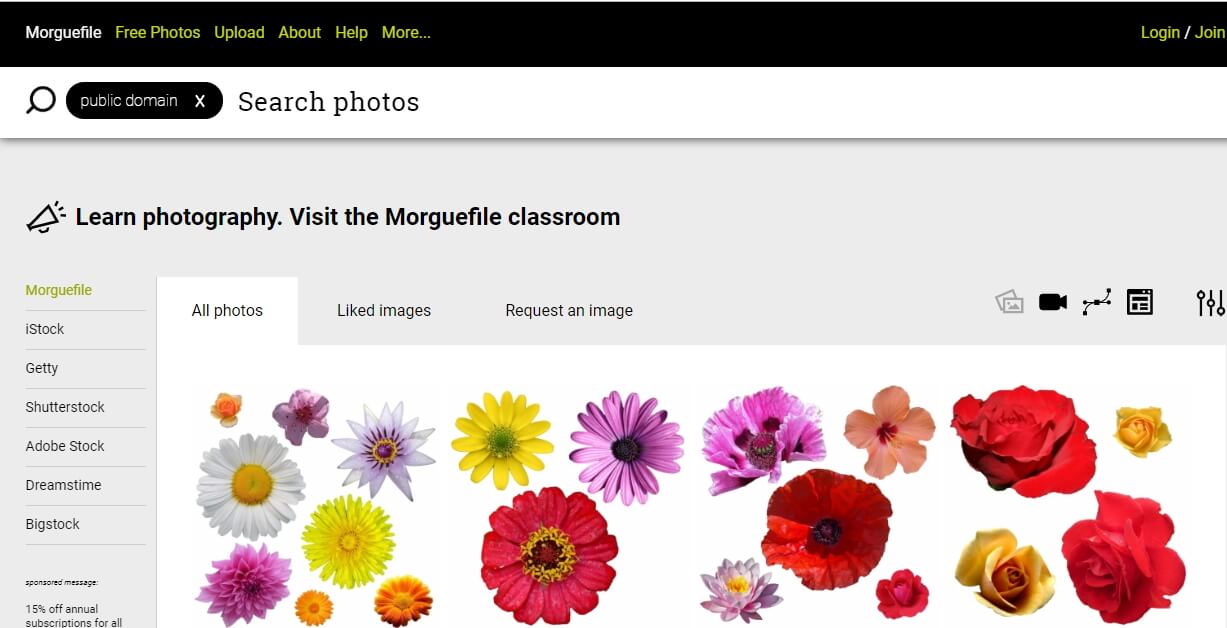
Morguefile is a website that offers stock footage to its users, but some of the images can’t be downloaded for free. That’s why you must click on the Free Photos tab before you start searching for public domain images on this website. The website hosts nearly 400.000 photos, videos, and vector graphics, but you must make sure that a file you want to download is within the public domain before you download it. The only downside is that the images aren’t organized into categories which can make finding the images you’re searching for more difficult than it needs to be.
Pros:
- Creating an account on Morguefile is free
- All free photos can be used on commercial projects
Cons:
- Images can be organized better
- Fewer free images than on other public domain image websites
8. Public Domain Archive
As the website’s name indicates, this is an archive of public domain images you can download for free and use in commercial contexts. All photos are organized into categories like abstract, free stock photos, people or wood which makes the search simpler. However, these categories don’t contain more than a few hundred photos and some of them offer as few as five pictures you can download. All photos are in high resolution and ready for professional use. The download process can be completed effortlessly in just a few quick steps. New images are added on a weekly basis.
Pros:
- Professional quality of images
- All images are free
Cons:
- A limited selection of photos
- Doesn’t offer vector graphics
9. NYPL Digital Gallery

NYPL Digital Gallery is an excellent resource for anyone who is not interested in stock photography. The New Your Public Library has made hundreds of thousands of historical images available to the public and you can use it to browse through items, collections or divisions. Before you enter a keyword you should click on the search only public domain materials tick box to ensure that the search results are going to display only images that can be used without restrictions. Additionally, the NYPL Digital Gallery lets you browse through its collection of digital books while its collections of photographs include the work of some of the highly esteemed American photographers.
Pros
- Public domain images are available in different resolutions
- Offers valuable research materials
Cons
- Some images are subject to copyright
- Only aimed at scholars and researchers
10. Viintage
Viintage is a gold mine for graphic designers as it grants them access to hundreds of vintage posters, book covers, and images. However, the amount of public domain images this website offers is limited and if you want to download the images from the collections of works created by famous artists from the late 19th and early 20th centuries you must purchase the premium version of Viintage. The website lacks some basic search options as it only allows you to type in the search term into the search bar. The images are not organized into categories which further complicates the process of finding a public domain image you’re looking for.
Pros:
- Offers a collection of rare vintage public domain images
- A great resource for graphic designers
Cons:
- Most images on Viintage can’t be downloaded for free
- Search tools are far from perfect
You may also like: Best Image Hosting Sites >>
How to Cite Public Domain Images Properly?
If you’re planning on using a public domain image in a blog or on your website, you must cite the source from which you acquired a particular image. The image citations should include the following information:
- The title of the image
- Author’s name
- Information about the institution at which an image is kept
- The source from which you acquired an image
In case you don’t have access to all of these information or if the information is simply not available you should include all details about a public domain image you have the access to. Furthermore, there are several styles of image citations that depend on the source from which an image was acquired.
Conclusion
Spending large sums of money on images you can use in commercial or private projects is not always necessary. The public domain images are widely available and they can be used in a broad range of contexts. Which website that lets you download public domain images do you like to use the most? Leave a comment and share your opinions with us.
Dont worry when you forget the syntax of an HTML element, like and iframe, a link, a table, an image or anything else. Visit HTML CheatSheet and generate the code you need.

Liza Brown
Liza Brown is a writer and a lover of all things video.
Follow @Liza Brown
Liza Brown
Mar 27, 2024• Proven solutions
Finding an image you like on the Internet doesn’t take long, since almost every website you can stumble upon, contains at least one picture. This doesn’t mean that you can just download any photo and use it in your blog, online marketing campaign or for any other purpose. Moreover, stock image websites like Getty Images or iStock let you purchase the right to use a photo commercially. As a reaction to an expanding stock image industry, many photographers, museums and cultural institutions are choosing to forfeit their rights and to publish public domain images. So, in this article, we are going to take you through the ten best public domain image websites where you can download pictures for free.
What Are Public Domain Images?
By definition, public domain images are photos, vectors or clip art that are available to anyone because their copyright has either expired or they never had a copyright owner. Consequently, anyone can use these images for both commercial or private projects without having to purchase the rights to do so. An image can enter a public domain under the following circumstances:
- Scientists, educators or artists can use the Creative Commons Zero (CC0) license to dedicate their images to the public domain
- A picture’s copyright is no longer in effect
- A photo was never the subject to copyright
It is of utmost importance to check if an image is within the public domain before you use it publicly in order to avoid potential legal complications.
How and Where to Find Public Domain Images?
A simple google search will reveal hundreds of websites that let you download public domain and royalty-free images. Which source you’re going to use depends on the type of image you’re looking for, since some websites are dedicated only to photography, while others feature impressive collections of public domain images of artworks. In addition, you’ll only want to download public domain images from the websites that offer information about the author because using a public domain image without crediting its author is strictly prohibited.
Best Websites for Downloading Public Domain Images
We’ve searched the Internet and we utilized our results to compile a collection of the most reliable websites that grant its users access to vast numbers of public domain images. Let’s take a look at some of the best websites that let you download public domain images.
1. Pexels

Graphic designers and all other creatives in constant need of a fresh supply of public domain images don’t need a special introduction to Pexels. The stock image platform is dedicated to photography and video, so you can’t use it to search for vectors or clip art. Even so, you can use Pexles to search for public domain images based on a particular keyword or browse through its collection of free images and discover photos spontaneously. Clicking on the Popular Searches tab will enable you to see the images from Light, Nature or Animals and it will shorten the amount of time you have to spend looking for a photo you want to download.
Pros:
- Neatly organized website
- Free and easy sign-up
- Offers a huge selection of free public domain images and videos according to the CC0 license
- Hand-picked High quality Images
Cons:
- Some categories should contain more images
- Optimizing the search terms can be difficult
2. Pixabay

Besides offering an impressive collection of royalty-free photos, Pixabay also lets you search for public domain vectors, illustrations, and videos. The website hosts more than a million high-resolution photos and videos you can download for free. To make things even better, becoming a member of the Pixabay’s community and creating an account on this platform won’t take more than a few minutes of your time. Pixabay also offers advanced search tools that enable you to combine searches, search for the author of an image or group search terms. In addition, you can also browse through the photographers that contribute their images to the platform on a regular basis.
Pros:
- Powerful search tools and various filters
- Huge collection of public domain images
Cons
- Customer support could be better
3. Wikimedia Commons

This is probably the largest website on the Internet where you can download public domain images. There are more than 49 million images, illustrations, vector graphics and videos available that can be downloaded for free. Some media files on Wikimedia Commons have certain restrictions, but these restrictions are mostly related to image citations, which means that you can use them only if you credit the author. Such a huge selection of media files can be overwhelming for the newcomers to the Wikimedia Commons platform, but once you grow accustomed to the website’s interface discovering images becomes a straightforward process.
Pros:
- All images are available in high resolution
- Nearly all images can be used without any restrictions
Cons:
- Getting used to the website’s interface takes time
- The number of search results can be overwhelming
4. Flickr Commons

For more than a decade Flickr has been a popular online destination for photographers in need of a platform that enables them to present their work. The Flickr Commons is a project that unites more than a hundred institutions in an effort to create a library of public domain images. The project makes available a stunning amount of historical photographs and it grants you access to highly esteemed collections of photographs. Flick Commons is perfectly suited for researchers and scholars in need of public domain photos, they can use in their essays or research papers.
Pros:
- Unlimited access to historical photos
- Extends the knowledge available to the general public
Cons:
- Doesn’t offer videos or illustrations
- Search results are poorly organized
5. Unsplash

With a library that contains over 800,000 photos, Unsplash is easily one of the largest websites that offer public domain images. All pictures on this platform are organized into different categories, which makes finding a photo you want to use in a commercial or non-commercial project a relatively simple process. Alternatively, you can insert a keyword into a search bar and Unsplash will show you the results within seconds. However, the images you can find on this platform are similar to those you can purchase on stock photography websites, although some of them have an artistic touch that is hard to find on the majority of stock photos.
Pros:
- Excellent source of high-resolution photos
- Quick and easy search
Cons:
- Unsplash is dedicated solely to photography
- Limited amount of available public domain images
6. From Old Books
In case you are searching for images from old books you should look no further. This is a private collection of 2,600 images that are hard to find anywhere else on the Internet. You can browse through woodcuts, old texts or old holiday images, which makes this platform an excellent choice for anyone interested in rare images that were featured in old books. All pictures you can find on the From Old Books website are free to use on non-commercial projects, but you must pay a small fee if you want to download a high-resolution image you can use on a commercial project.
- Images are organized into categories
- Access to rare images
Cons
- Some images are not free
- Rudimentary website design
7. Morguefile

Morguefile is a website that offers stock footage to its users, but some of the images can’t be downloaded for free. That’s why you must click on the Free Photos tab before you start searching for public domain images on this website. The website hosts nearly 400.000 photos, videos, and vector graphics, but you must make sure that a file you want to download is within the public domain before you download it. The only downside is that the images aren’t organized into categories which can make finding the images you’re searching for more difficult than it needs to be.
Pros:
- Creating an account on Morguefile is free
- All free photos can be used on commercial projects
Cons:
- Images can be organized better
- Fewer free images than on other public domain image websites
8. Public Domain Archive
As the website’s name indicates, this is an archive of public domain images you can download for free and use in commercial contexts. All photos are organized into categories like abstract, free stock photos, people or wood which makes the search simpler. However, these categories don’t contain more than a few hundred photos and some of them offer as few as five pictures you can download. All photos are in high resolution and ready for professional use. The download process can be completed effortlessly in just a few quick steps. New images are added on a weekly basis.
Pros:
- Professional quality of images
- All images are free
Cons:
- A limited selection of photos
- Doesn’t offer vector graphics
9. NYPL Digital Gallery

NYPL Digital Gallery is an excellent resource for anyone who is not interested in stock photography. The New Your Public Library has made hundreds of thousands of historical images available to the public and you can use it to browse through items, collections or divisions. Before you enter a keyword you should click on the search only public domain materials tick box to ensure that the search results are going to display only images that can be used without restrictions. Additionally, the NYPL Digital Gallery lets you browse through its collection of digital books while its collections of photographs include the work of some of the highly esteemed American photographers.
Pros
- Public domain images are available in different resolutions
- Offers valuable research materials
Cons
- Some images are subject to copyright
- Only aimed at scholars and researchers
10. Viintage
Viintage is a gold mine for graphic designers as it grants them access to hundreds of vintage posters, book covers, and images. However, the amount of public domain images this website offers is limited and if you want to download the images from the collections of works created by famous artists from the late 19th and early 20th centuries you must purchase the premium version of Viintage. The website lacks some basic search options as it only allows you to type in the search term into the search bar. The images are not organized into categories which further complicates the process of finding a public domain image you’re looking for.
Pros:
- Offers a collection of rare vintage public domain images
- A great resource for graphic designers
Cons:
- Most images on Viintage can’t be downloaded for free
- Search tools are far from perfect
You may also like: Best Image Hosting Sites >>
How to Cite Public Domain Images Properly?
If you’re planning on using a public domain image in a blog or on your website, you must cite the source from which you acquired a particular image. The image citations should include the following information:
- The title of the image
- Author’s name
- Information about the institution at which an image is kept
- The source from which you acquired an image
In case you don’t have access to all of these information or if the information is simply not available you should include all details about a public domain image you have the access to. Furthermore, there are several styles of image citations that depend on the source from which an image was acquired.
Conclusion
Spending large sums of money on images you can use in commercial or private projects is not always necessary. The public domain images are widely available and they can be used in a broad range of contexts. Which website that lets you download public domain images do you like to use the most? Leave a comment and share your opinions with us.
Dont worry when you forget the syntax of an HTML element, like and iframe, a link, a table, an image or anything else. Visit HTML CheatSheet and generate the code you need.

Liza Brown
Liza Brown is a writer and a lover of all things video.
Follow @Liza Brown
Liza Brown
Mar 27, 2024• Proven solutions
Finding an image you like on the Internet doesn’t take long, since almost every website you can stumble upon, contains at least one picture. This doesn’t mean that you can just download any photo and use it in your blog, online marketing campaign or for any other purpose. Moreover, stock image websites like Getty Images or iStock let you purchase the right to use a photo commercially. As a reaction to an expanding stock image industry, many photographers, museums and cultural institutions are choosing to forfeit their rights and to publish public domain images. So, in this article, we are going to take you through the ten best public domain image websites where you can download pictures for free.
What Are Public Domain Images?
By definition, public domain images are photos, vectors or clip art that are available to anyone because their copyright has either expired or they never had a copyright owner. Consequently, anyone can use these images for both commercial or private projects without having to purchase the rights to do so. An image can enter a public domain under the following circumstances:
- Scientists, educators or artists can use the Creative Commons Zero (CC0) license to dedicate their images to the public domain
- A picture’s copyright is no longer in effect
- A photo was never the subject to copyright
It is of utmost importance to check if an image is within the public domain before you use it publicly in order to avoid potential legal complications.
How and Where to Find Public Domain Images?
A simple google search will reveal hundreds of websites that let you download public domain and royalty-free images. Which source you’re going to use depends on the type of image you’re looking for, since some websites are dedicated only to photography, while others feature impressive collections of public domain images of artworks. In addition, you’ll only want to download public domain images from the websites that offer information about the author because using a public domain image without crediting its author is strictly prohibited.
Best Websites for Downloading Public Domain Images
We’ve searched the Internet and we utilized our results to compile a collection of the most reliable websites that grant its users access to vast numbers of public domain images. Let’s take a look at some of the best websites that let you download public domain images.
1. Pexels

Graphic designers and all other creatives in constant need of a fresh supply of public domain images don’t need a special introduction to Pexels. The stock image platform is dedicated to photography and video, so you can’t use it to search for vectors or clip art. Even so, you can use Pexles to search for public domain images based on a particular keyword or browse through its collection of free images and discover photos spontaneously. Clicking on the Popular Searches tab will enable you to see the images from Light, Nature or Animals and it will shorten the amount of time you have to spend looking for a photo you want to download.
Pros:
- Neatly organized website
- Free and easy sign-up
- Offers a huge selection of free public domain images and videos according to the CC0 license
- Hand-picked High quality Images
Cons:
- Some categories should contain more images
- Optimizing the search terms can be difficult
2. Pixabay

Besides offering an impressive collection of royalty-free photos, Pixabay also lets you search for public domain vectors, illustrations, and videos. The website hosts more than a million high-resolution photos and videos you can download for free. To make things even better, becoming a member of the Pixabay’s community and creating an account on this platform won’t take more than a few minutes of your time. Pixabay also offers advanced search tools that enable you to combine searches, search for the author of an image or group search terms. In addition, you can also browse through the photographers that contribute their images to the platform on a regular basis.
Pros:
- Powerful search tools and various filters
- Huge collection of public domain images
Cons
- Customer support could be better
3. Wikimedia Commons

This is probably the largest website on the Internet where you can download public domain images. There are more than 49 million images, illustrations, vector graphics and videos available that can be downloaded for free. Some media files on Wikimedia Commons have certain restrictions, but these restrictions are mostly related to image citations, which means that you can use them only if you credit the author. Such a huge selection of media files can be overwhelming for the newcomers to the Wikimedia Commons platform, but once you grow accustomed to the website’s interface discovering images becomes a straightforward process.
Pros:
- All images are available in high resolution
- Nearly all images can be used without any restrictions
Cons:
- Getting used to the website’s interface takes time
- The number of search results can be overwhelming
4. Flickr Commons

For more than a decade Flickr has been a popular online destination for photographers in need of a platform that enables them to present their work. The Flickr Commons is a project that unites more than a hundred institutions in an effort to create a library of public domain images. The project makes available a stunning amount of historical photographs and it grants you access to highly esteemed collections of photographs. Flick Commons is perfectly suited for researchers and scholars in need of public domain photos, they can use in their essays or research papers.
Pros:
- Unlimited access to historical photos
- Extends the knowledge available to the general public
Cons:
- Doesn’t offer videos or illustrations
- Search results are poorly organized
5. Unsplash

With a library that contains over 800,000 photos, Unsplash is easily one of the largest websites that offer public domain images. All pictures on this platform are organized into different categories, which makes finding a photo you want to use in a commercial or non-commercial project a relatively simple process. Alternatively, you can insert a keyword into a search bar and Unsplash will show you the results within seconds. However, the images you can find on this platform are similar to those you can purchase on stock photography websites, although some of them have an artistic touch that is hard to find on the majority of stock photos.
Pros:
- Excellent source of high-resolution photos
- Quick and easy search
Cons:
- Unsplash is dedicated solely to photography
- Limited amount of available public domain images
6. From Old Books
In case you are searching for images from old books you should look no further. This is a private collection of 2,600 images that are hard to find anywhere else on the Internet. You can browse through woodcuts, old texts or old holiday images, which makes this platform an excellent choice for anyone interested in rare images that were featured in old books. All pictures you can find on the From Old Books website are free to use on non-commercial projects, but you must pay a small fee if you want to download a high-resolution image you can use on a commercial project.
- Images are organized into categories
- Access to rare images
Cons
- Some images are not free
- Rudimentary website design
7. Morguefile

Morguefile is a website that offers stock footage to its users, but some of the images can’t be downloaded for free. That’s why you must click on the Free Photos tab before you start searching for public domain images on this website. The website hosts nearly 400.000 photos, videos, and vector graphics, but you must make sure that a file you want to download is within the public domain before you download it. The only downside is that the images aren’t organized into categories which can make finding the images you’re searching for more difficult than it needs to be.
Pros:
- Creating an account on Morguefile is free
- All free photos can be used on commercial projects
Cons:
- Images can be organized better
- Fewer free images than on other public domain image websites
8. Public Domain Archive
As the website’s name indicates, this is an archive of public domain images you can download for free and use in commercial contexts. All photos are organized into categories like abstract, free stock photos, people or wood which makes the search simpler. However, these categories don’t contain more than a few hundred photos and some of them offer as few as five pictures you can download. All photos are in high resolution and ready for professional use. The download process can be completed effortlessly in just a few quick steps. New images are added on a weekly basis.
Pros:
- Professional quality of images
- All images are free
Cons:
- A limited selection of photos
- Doesn’t offer vector graphics
9. NYPL Digital Gallery

NYPL Digital Gallery is an excellent resource for anyone who is not interested in stock photography. The New Your Public Library has made hundreds of thousands of historical images available to the public and you can use it to browse through items, collections or divisions. Before you enter a keyword you should click on the search only public domain materials tick box to ensure that the search results are going to display only images that can be used without restrictions. Additionally, the NYPL Digital Gallery lets you browse through its collection of digital books while its collections of photographs include the work of some of the highly esteemed American photographers.
Pros
- Public domain images are available in different resolutions
- Offers valuable research materials
Cons
- Some images are subject to copyright
- Only aimed at scholars and researchers
10. Viintage
Viintage is a gold mine for graphic designers as it grants them access to hundreds of vintage posters, book covers, and images. However, the amount of public domain images this website offers is limited and if you want to download the images from the collections of works created by famous artists from the late 19th and early 20th centuries you must purchase the premium version of Viintage. The website lacks some basic search options as it only allows you to type in the search term into the search bar. The images are not organized into categories which further complicates the process of finding a public domain image you’re looking for.
Pros:
- Offers a collection of rare vintage public domain images
- A great resource for graphic designers
Cons:
- Most images on Viintage can’t be downloaded for free
- Search tools are far from perfect
You may also like: Best Image Hosting Sites >>
How to Cite Public Domain Images Properly?
If you’re planning on using a public domain image in a blog or on your website, you must cite the source from which you acquired a particular image. The image citations should include the following information:
- The title of the image
- Author’s name
- Information about the institution at which an image is kept
- The source from which you acquired an image
In case you don’t have access to all of these information or if the information is simply not available you should include all details about a public domain image you have the access to. Furthermore, there are several styles of image citations that depend on the source from which an image was acquired.
Conclusion
Spending large sums of money on images you can use in commercial or private projects is not always necessary. The public domain images are widely available and they can be used in a broad range of contexts. Which website that lets you download public domain images do you like to use the most? Leave a comment and share your opinions with us.
Dont worry when you forget the syntax of an HTML element, like and iframe, a link, a table, an image or anything else. Visit HTML CheatSheet and generate the code you need.

Liza Brown
Liza Brown is a writer and a lover of all things video.
Follow @Liza Brown
Liza Brown
Mar 27, 2024• Proven solutions
Finding an image you like on the Internet doesn’t take long, since almost every website you can stumble upon, contains at least one picture. This doesn’t mean that you can just download any photo and use it in your blog, online marketing campaign or for any other purpose. Moreover, stock image websites like Getty Images or iStock let you purchase the right to use a photo commercially. As a reaction to an expanding stock image industry, many photographers, museums and cultural institutions are choosing to forfeit their rights and to publish public domain images. So, in this article, we are going to take you through the ten best public domain image websites where you can download pictures for free.
What Are Public Domain Images?
By definition, public domain images are photos, vectors or clip art that are available to anyone because their copyright has either expired or they never had a copyright owner. Consequently, anyone can use these images for both commercial or private projects without having to purchase the rights to do so. An image can enter a public domain under the following circumstances:
- Scientists, educators or artists can use the Creative Commons Zero (CC0) license to dedicate their images to the public domain
- A picture’s copyright is no longer in effect
- A photo was never the subject to copyright
It is of utmost importance to check if an image is within the public domain before you use it publicly in order to avoid potential legal complications.
How and Where to Find Public Domain Images?
A simple google search will reveal hundreds of websites that let you download public domain and royalty-free images. Which source you’re going to use depends on the type of image you’re looking for, since some websites are dedicated only to photography, while others feature impressive collections of public domain images of artworks. In addition, you’ll only want to download public domain images from the websites that offer information about the author because using a public domain image without crediting its author is strictly prohibited.
Best Websites for Downloading Public Domain Images
We’ve searched the Internet and we utilized our results to compile a collection of the most reliable websites that grant its users access to vast numbers of public domain images. Let’s take a look at some of the best websites that let you download public domain images.
1. Pexels

Graphic designers and all other creatives in constant need of a fresh supply of public domain images don’t need a special introduction to Pexels. The stock image platform is dedicated to photography and video, so you can’t use it to search for vectors or clip art. Even so, you can use Pexles to search for public domain images based on a particular keyword or browse through its collection of free images and discover photos spontaneously. Clicking on the Popular Searches tab will enable you to see the images from Light, Nature or Animals and it will shorten the amount of time you have to spend looking for a photo you want to download.
Pros:
- Neatly organized website
- Free and easy sign-up
- Offers a huge selection of free public domain images and videos according to the CC0 license
- Hand-picked High quality Images
Cons:
- Some categories should contain more images
- Optimizing the search terms can be difficult
2. Pixabay

Besides offering an impressive collection of royalty-free photos, Pixabay also lets you search for public domain vectors, illustrations, and videos. The website hosts more than a million high-resolution photos and videos you can download for free. To make things even better, becoming a member of the Pixabay’s community and creating an account on this platform won’t take more than a few minutes of your time. Pixabay also offers advanced search tools that enable you to combine searches, search for the author of an image or group search terms. In addition, you can also browse through the photographers that contribute their images to the platform on a regular basis.
Pros:
- Powerful search tools and various filters
- Huge collection of public domain images
Cons
- Customer support could be better
3. Wikimedia Commons

This is probably the largest website on the Internet where you can download public domain images. There are more than 49 million images, illustrations, vector graphics and videos available that can be downloaded for free. Some media files on Wikimedia Commons have certain restrictions, but these restrictions are mostly related to image citations, which means that you can use them only if you credit the author. Such a huge selection of media files can be overwhelming for the newcomers to the Wikimedia Commons platform, but once you grow accustomed to the website’s interface discovering images becomes a straightforward process.
Pros:
- All images are available in high resolution
- Nearly all images can be used without any restrictions
Cons:
- Getting used to the website’s interface takes time
- The number of search results can be overwhelming
4. Flickr Commons

For more than a decade Flickr has been a popular online destination for photographers in need of a platform that enables them to present their work. The Flickr Commons is a project that unites more than a hundred institutions in an effort to create a library of public domain images. The project makes available a stunning amount of historical photographs and it grants you access to highly esteemed collections of photographs. Flick Commons is perfectly suited for researchers and scholars in need of public domain photos, they can use in their essays or research papers.
Pros:
- Unlimited access to historical photos
- Extends the knowledge available to the general public
Cons:
- Doesn’t offer videos or illustrations
- Search results are poorly organized
5. Unsplash

With a library that contains over 800,000 photos, Unsplash is easily one of the largest websites that offer public domain images. All pictures on this platform are organized into different categories, which makes finding a photo you want to use in a commercial or non-commercial project a relatively simple process. Alternatively, you can insert a keyword into a search bar and Unsplash will show you the results within seconds. However, the images you can find on this platform are similar to those you can purchase on stock photography websites, although some of them have an artistic touch that is hard to find on the majority of stock photos.
Pros:
- Excellent source of high-resolution photos
- Quick and easy search
Cons:
- Unsplash is dedicated solely to photography
- Limited amount of available public domain images
6. From Old Books
In case you are searching for images from old books you should look no further. This is a private collection of 2,600 images that are hard to find anywhere else on the Internet. You can browse through woodcuts, old texts or old holiday images, which makes this platform an excellent choice for anyone interested in rare images that were featured in old books. All pictures you can find on the From Old Books website are free to use on non-commercial projects, but you must pay a small fee if you want to download a high-resolution image you can use on a commercial project.
- Images are organized into categories
- Access to rare images
Cons
- Some images are not free
- Rudimentary website design
7. Morguefile

Morguefile is a website that offers stock footage to its users, but some of the images can’t be downloaded for free. That’s why you must click on the Free Photos tab before you start searching for public domain images on this website. The website hosts nearly 400.000 photos, videos, and vector graphics, but you must make sure that a file you want to download is within the public domain before you download it. The only downside is that the images aren’t organized into categories which can make finding the images you’re searching for more difficult than it needs to be.
Pros:
- Creating an account on Morguefile is free
- All free photos can be used on commercial projects
Cons:
- Images can be organized better
- Fewer free images than on other public domain image websites
8. Public Domain Archive
As the website’s name indicates, this is an archive of public domain images you can download for free and use in commercial contexts. All photos are organized into categories like abstract, free stock photos, people or wood which makes the search simpler. However, these categories don’t contain more than a few hundred photos and some of them offer as few as five pictures you can download. All photos are in high resolution and ready for professional use. The download process can be completed effortlessly in just a few quick steps. New images are added on a weekly basis.
Pros:
- Professional quality of images
- All images are free
Cons:
- A limited selection of photos
- Doesn’t offer vector graphics
9. NYPL Digital Gallery

NYPL Digital Gallery is an excellent resource for anyone who is not interested in stock photography. The New Your Public Library has made hundreds of thousands of historical images available to the public and you can use it to browse through items, collections or divisions. Before you enter a keyword you should click on the search only public domain materials tick box to ensure that the search results are going to display only images that can be used without restrictions. Additionally, the NYPL Digital Gallery lets you browse through its collection of digital books while its collections of photographs include the work of some of the highly esteemed American photographers.
Pros
- Public domain images are available in different resolutions
- Offers valuable research materials
Cons
- Some images are subject to copyright
- Only aimed at scholars and researchers
10. Viintage
Viintage is a gold mine for graphic designers as it grants them access to hundreds of vintage posters, book covers, and images. However, the amount of public domain images this website offers is limited and if you want to download the images from the collections of works created by famous artists from the late 19th and early 20th centuries you must purchase the premium version of Viintage. The website lacks some basic search options as it only allows you to type in the search term into the search bar. The images are not organized into categories which further complicates the process of finding a public domain image you’re looking for.
Pros:
- Offers a collection of rare vintage public domain images
- A great resource for graphic designers
Cons:
- Most images on Viintage can’t be downloaded for free
- Search tools are far from perfect
You may also like: Best Image Hosting Sites >>
How to Cite Public Domain Images Properly?
If you’re planning on using a public domain image in a blog or on your website, you must cite the source from which you acquired a particular image. The image citations should include the following information:
- The title of the image
- Author’s name
- Information about the institution at which an image is kept
- The source from which you acquired an image
In case you don’t have access to all of these information or if the information is simply not available you should include all details about a public domain image you have the access to. Furthermore, there are several styles of image citations that depend on the source from which an image was acquired.
Conclusion
Spending large sums of money on images you can use in commercial or private projects is not always necessary. The public domain images are widely available and they can be used in a broad range of contexts. Which website that lets you download public domain images do you like to use the most? Leave a comment and share your opinions with us.
Dont worry when you forget the syntax of an HTML element, like and iframe, a link, a table, an image or anything else. Visit HTML CheatSheet and generate the code you need.

Liza Brown
Liza Brown is a writer and a lover of all things video.
Follow @Liza Brown
Reframe Your Videos in Seconds: Top Editor Choices
The auto-frame feature is needed to edit the videos professionally. Its purpose is to adjust the video clips so that the action of a scene is never out of the frame even after reformatting the video. Specifically, the quality of your video is not affected, and no frame is lost or damaged when you reformat the video for different aspect ratios.
The smart auto-reframe feature is mainly used for posting videos on social media platforms such as Facebook, Instagram, YouTube, etc. This article provides you with detailed information about the best video editors that are enriched with the smart auto-reframe feature. The method of using these tools is also provided.
Top Video Editors with Auto-Reframe for Smart Crop
Following are some of the best video editors that consist of an auto-reframe feature for smart crop:
1. Wondershare Filmora Video Editor
Supported OS: Windows and macOS
Pricing: Free trial, $ 79.99 for perpetual plan
For Win 7 or later (64-bit)
For macOS 10.12 or later
Wondershare Filmora Video Editor is a powerful and easy video editing software that provides different methods to save and share the video. This software includes GIF support, 4K editing support, and an audio equalizer. You can remove background noise from the video. Its key features also include video stabilization , color tuning, scene detection, advanced text editor and audio mixer,
Wondershare Filmora comes with plenty of smart features, among which auto-reframe is top of the list. It saves your editing time to create or edit a professional video. This feature can detect a moving object in your video and crops it automatically to suit different aspect ratios so you can post it on various platforms. In this way, it enhances the efficiency of your video. To use the auto-reframe feature in Filmora, you can follow the steps below:
Step 1: Install and Launch Software
Download the software and launch it on your devices. From Tools, select Auto Reframe.
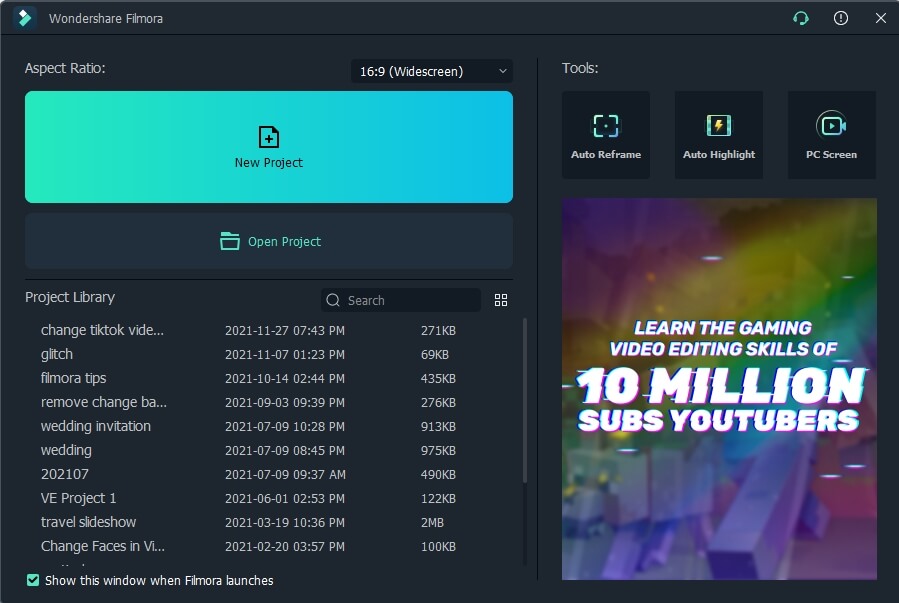
Step 2: Import File
Use the drag and drop feature to import the file or click on the Import button for selecting and importing it.

Step 3: Choose Aspect Ratio
To start reframing, select the aspect ratio you need. You can also define the motion speed of the reframed video clip to make it fast or slow or keep the original speed. And then click Analyze to apply changes. Here I will choose 9:16 portrait mode to take the example.
Step 4: Adjust Frame
Filmora will convert the video to the selected aspect ratio automatically. After analyzing, select the frame and adjust its position.
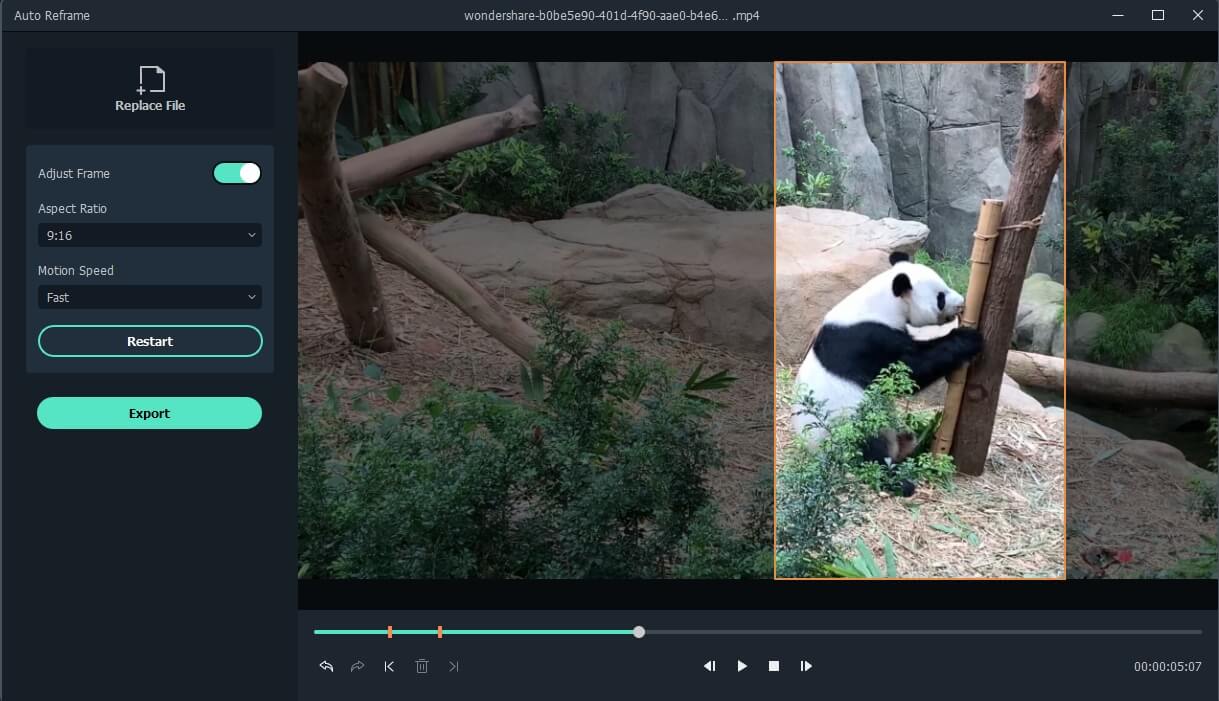
Step 4: Export File
Click the Export button to save the file when you are done with reframing, adjustment, and editing. Share it where you want to.
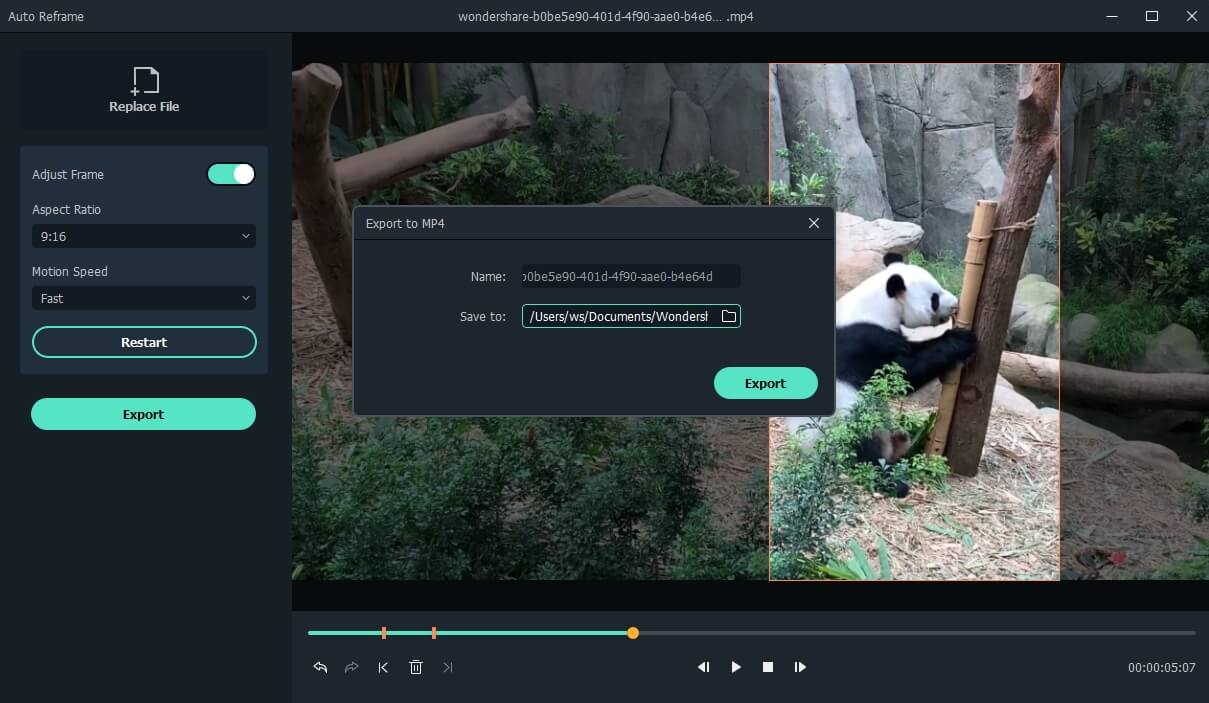
2. Adobe Premiere Rush
Supported OS: Android, iOS, Windows and macOS
Pricing: Free trial, $9.99 per month
Adobe Premiere Rush is a desktop and mobile video editing app that lets you create innovative videos from your computer or mobile phone. It enables you to control your creations with audio features and graphic templates. It allows you to capture, color-correct, change clip sequence, trim, add color filters, text overlays, and record voiceovers .
The feature of auto-reframe is also available in this software that allows you to adjust your video and do reframing. You can set the frames according to your needs and requirements through the application of Auto Reframe to your video without affecting its quality when uploaded on social media platforms.
Step 1: Download the Software
Download the software on your mobile or computer and launch it.
Step 2: Import a Video
Import a video to the software you want to edit and adjust its frames.
Step 3: Apply Auto Frame
Click Effects panel and then select Auto Reframe, which will automatically keep the most important parts of the shot in the frame, and then the process will be started.
Step 4: Adjust Frames and Add Effects
Click Adjust Frame to adjust frame size according to your needs. To add Pan and Zoom effects or other effects, click Effects, select Motion menu.
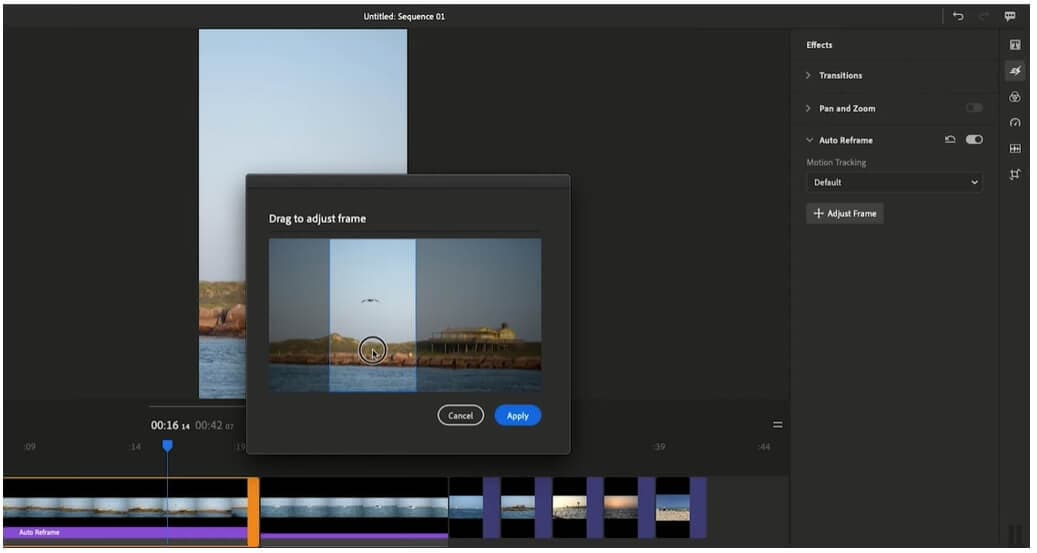
Step 4: Adjust and Export
Set the speed of the video and the clip duration, and then export your video when editing is done. Save it to your device and share it.
3. Adobe Premiere Pro
Supported OS: Windows and macOS
Pricing: $20.99 per month (annual plan monthly paid)
Adobe Premiere Pro is a video editing software that is flexible and efficient for professional videos. It consists of powerful creative tools for audio, graphics, and colors. It allows you to create simultaneous projects and use motion graphic templates to enhance your video. This software also provides the feature of VR audio editing, transitions, adding effects, etc.
Adobe has added the smart auto-reframe feature to the software, especially for the broadcasters to optimize their content for different social media platforms. Using the auto-reframe feature, they can edit video in both YouTube’s landscape interface and Instagram’s vertical format.
Step 1: Download and Launch Software
Download the software from its official website, install it and launch it to use.
Step 2: Select the Sequence
Right-click and select the Auto Reframe Sequence option. Click New Item and select Sequence to create a sequence or add an already shot sequence.
Step 3: Apply Auto Reframe Feature
Select Effects and double click Auto Reframe tab to apply its effects. Select Aspect Ratio for reframing the video.
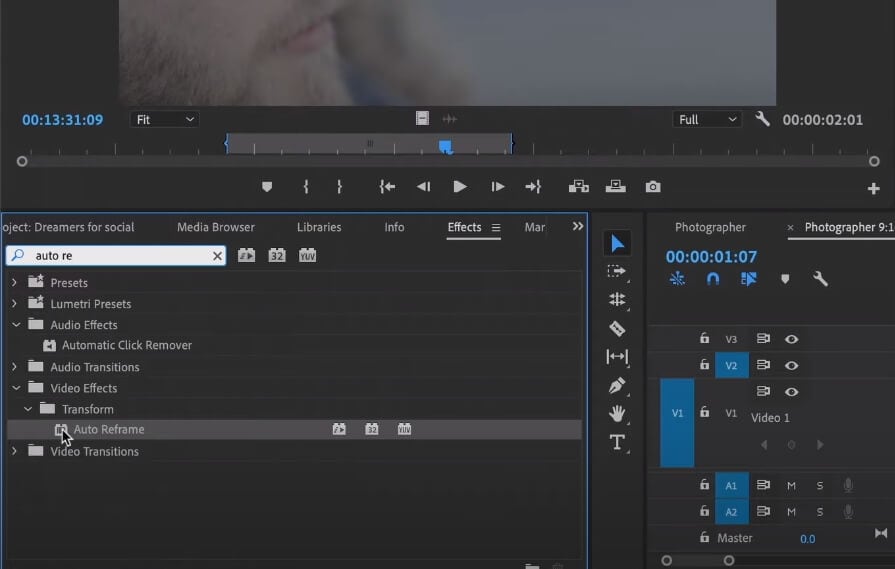
Step 4: Export and Save
Export the file when the auto frame feature is applied. Save it and share it.
4. Final Cut Pro X
Supported OS: Mac OS
Pricing: Free trial, $299.99
Final Cut Pro X was developed by Apple. It is a video editing software that allows you to edit a simple video to a traditional one because it consists of the Object Tracker for adding dynamic text to the video.
You can also add colors to the moving footage. You can apply tracking data to other graphics and text files to enhance your work.
The smart auto-frame feature present in Final Cut Pro X allows you to adjust the aspect ratios of the video file. Smart Conform feature will enable you to Auto Reframe in this Apple’s software where it works on sequences.
Step 1: Download and Install Software
Download Final Cut Pro X from its official website, install and launch it.
Step 2: Create Project
Create a project with the aspect ratio you need, i.e., vertical, landscape, square, etc, and click Smart Conform to apply Auto Reframe, and then set frame size and set the aspect ratio to maximize image quality. In this way, Final Cut Pro will analyze all the clips, focus on the most interesting parts, and automatically conform each clip to fill the entire frame.
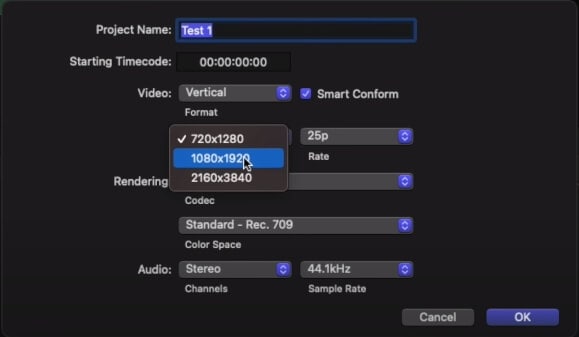
Step 3: Add File and Adjust
Add file to the timeline, and you will the video is auto reframed in the Preview window. You can skim through the project to check how the Smart Conform tool did on the rest of the clips.
If you find some frames are out of the edge, you can manually adjust its position with keyframing.
Step 4: Save File
After everything is finely adjusted, export the edited and adjusted video and save it to your device.
5. Kamua
Supported OS: Online tool available for all devices
Pricing: Free
Kamua is a video editing browser-based tool that does not require to be downloaded. It comes with a user-friendly interface that makes it easy to use and understand. You can add subtitles to your video using this tool. It allows you to add filters to your video to make it effective and gain the attention of your followers. Its Ai features let you crop the video efficiently.
You can change the dimensions of the video and aspect ratio from vertical to horizontal using the Auto Reframe feature. In this software, the Auto Reframe feature is enabled by the AutoCrop feature that allows you to resize and reframe your video or the clips that have movement.
Step 1: Visit the Official Website
Open the official website of Kamua to use it for reframing: https://kamua.com/ .
Step 2: Select Aspect Ratio
Open Crop Settings and set the Aspect ratio for your file
Step 3: Apply Feature
Toggle AutoCrop and click Generate AutoCrop Preview. Set the aspect ratio and video dimensions
Step 4: Export File
Export the edited file when you are done with the reframing and resizing step. Save the file and share it to your desired platform.
Note: Since 16 November, 2021, Kamua is part of Jellysmack and the services has been discontinued. If you didn’t register it before, you may can’t use the features mentioned above.
Conclusion
The modern video editing software comes with the feature of smart auto reframing. This feature allows you to upload your video according to the platform where you want to upload it. For example, if you need to upload a video on YouTube, you can set the aspect ratio in the landscape interface. And if you want to upload your video on Instagram, you can set the aspect ratio to vertical format. These tools also allow you to set video dimensions. They not only allow you to edit videos but also the images having motion.
For Win 7 or later (64-bit)
For macOS 10.12 or later
Wondershare Filmora Video Editor is a powerful and easy video editing software that provides different methods to save and share the video. This software includes GIF support, 4K editing support, and an audio equalizer. You can remove background noise from the video. Its key features also include video stabilization , color tuning, scene detection, advanced text editor and audio mixer,
Wondershare Filmora comes with plenty of smart features, among which auto-reframe is top of the list. It saves your editing time to create or edit a professional video. This feature can detect a moving object in your video and crops it automatically to suit different aspect ratios so you can post it on various platforms. In this way, it enhances the efficiency of your video. To use the auto-reframe feature in Filmora, you can follow the steps below:
Step 1: Install and Launch Software
Download the software and launch it on your devices. From Tools, select Auto Reframe.

Step 2: Import File
Use the drag and drop feature to import the file or click on the Import button for selecting and importing it.

Step 3: Choose Aspect Ratio
To start reframing, select the aspect ratio you need. You can also define the motion speed of the reframed video clip to make it fast or slow or keep the original speed. And then click Analyze to apply changes. Here I will choose 9:16 portrait mode to take the example.
Step 4: Adjust Frame
Filmora will convert the video to the selected aspect ratio automatically. After analyzing, select the frame and adjust its position.

Step 4: Export File
Click the Export button to save the file when you are done with reframing, adjustment, and editing. Share it where you want to.

2. Adobe Premiere Rush
Supported OS: Android, iOS, Windows and macOS
Pricing: Free trial, $9.99 per month
Adobe Premiere Rush is a desktop and mobile video editing app that lets you create innovative videos from your computer or mobile phone. It enables you to control your creations with audio features and graphic templates. It allows you to capture, color-correct, change clip sequence, trim, add color filters, text overlays, and record voiceovers .
The feature of auto-reframe is also available in this software that allows you to adjust your video and do reframing. You can set the frames according to your needs and requirements through the application of Auto Reframe to your video without affecting its quality when uploaded on social media platforms.
Step 1: Download the Software
Download the software on your mobile or computer and launch it.
Step 2: Import a Video
Import a video to the software you want to edit and adjust its frames.
Step 3: Apply Auto Frame
Click Effects panel and then select Auto Reframe, which will automatically keep the most important parts of the shot in the frame, and then the process will be started.
Step 4: Adjust Frames and Add Effects
Click Adjust Frame to adjust frame size according to your needs. To add Pan and Zoom effects or other effects, click Effects, select Motion menu.

Step 4: Adjust and Export
Set the speed of the video and the clip duration, and then export your video when editing is done. Save it to your device and share it.
3. Adobe Premiere Pro
Supported OS: Windows and macOS
Pricing: $20.99 per month (annual plan monthly paid)
Adobe Premiere Pro is a video editing software that is flexible and efficient for professional videos. It consists of powerful creative tools for audio, graphics, and colors. It allows you to create simultaneous projects and use motion graphic templates to enhance your video. This software also provides the feature of VR audio editing, transitions, adding effects, etc.
Adobe has added the smart auto-reframe feature to the software, especially for the broadcasters to optimize their content for different social media platforms. Using the auto-reframe feature, they can edit video in both YouTube’s landscape interface and Instagram’s vertical format.
Step 1: Download and Launch Software
Download the software from its official website, install it and launch it to use.
Step 2: Select the Sequence
Right-click and select the Auto Reframe Sequence option. Click New Item and select Sequence to create a sequence or add an already shot sequence.
Step 3: Apply Auto Reframe Feature
Select Effects and double click Auto Reframe tab to apply its effects. Select Aspect Ratio for reframing the video.

Step 4: Export and Save
Export the file when the auto frame feature is applied. Save it and share it.
4. Final Cut Pro X
Supported OS: Mac OS
Pricing: Free trial, $299.99
Final Cut Pro X was developed by Apple. It is a video editing software that allows you to edit a simple video to a traditional one because it consists of the Object Tracker for adding dynamic text to the video.
You can also add colors to the moving footage. You can apply tracking data to other graphics and text files to enhance your work.
The smart auto-frame feature present in Final Cut Pro X allows you to adjust the aspect ratios of the video file. Smart Conform feature will enable you to Auto Reframe in this Apple’s software where it works on sequences.
Step 1: Download and Install Software
Download Final Cut Pro X from its official website, install and launch it.
Step 2: Create Project
Create a project with the aspect ratio you need, i.e., vertical, landscape, square, etc, and click Smart Conform to apply Auto Reframe, and then set frame size and set the aspect ratio to maximize image quality. In this way, Final Cut Pro will analyze all the clips, focus on the most interesting parts, and automatically conform each clip to fill the entire frame.

Step 3: Add File and Adjust
Add file to the timeline, and you will the video is auto reframed in the Preview window. You can skim through the project to check how the Smart Conform tool did on the rest of the clips.
If you find some frames are out of the edge, you can manually adjust its position with keyframing.
Step 4: Save File
After everything is finely adjusted, export the edited and adjusted video and save it to your device.
5. Kamua
Supported OS: Online tool available for all devices
Pricing: Free
Kamua is a video editing browser-based tool that does not require to be downloaded. It comes with a user-friendly interface that makes it easy to use and understand. You can add subtitles to your video using this tool. It allows you to add filters to your video to make it effective and gain the attention of your followers. Its Ai features let you crop the video efficiently.
You can change the dimensions of the video and aspect ratio from vertical to horizontal using the Auto Reframe feature. In this software, the Auto Reframe feature is enabled by the AutoCrop feature that allows you to resize and reframe your video or the clips that have movement.
Step 1: Visit the Official Website
Open the official website of Kamua to use it for reframing: https://kamua.com/ .
Step 2: Select Aspect Ratio
Open Crop Settings and set the Aspect ratio for your file
Step 3: Apply Feature
Toggle AutoCrop and click Generate AutoCrop Preview. Set the aspect ratio and video dimensions
Step 4: Export File
Export the edited file when you are done with the reframing and resizing step. Save the file and share it to your desired platform.
Note: Since 16 November, 2021, Kamua is part of Jellysmack and the services has been discontinued. If you didn’t register it before, you may can’t use the features mentioned above.
Conclusion
The modern video editing software comes with the feature of smart auto reframing. This feature allows you to upload your video according to the platform where you want to upload it. For example, if you need to upload a video on YouTube, you can set the aspect ratio in the landscape interface. And if you want to upload your video on Instagram, you can set the aspect ratio to vertical format. These tools also allow you to set video dimensions. They not only allow you to edit videos but also the images having motion.
For Win 7 or later (64-bit)
For macOS 10.12 or later
Wondershare Filmora Video Editor is a powerful and easy video editing software that provides different methods to save and share the video. This software includes GIF support, 4K editing support, and an audio equalizer. You can remove background noise from the video. Its key features also include video stabilization , color tuning, scene detection, advanced text editor and audio mixer,
Wondershare Filmora comes with plenty of smart features, among which auto-reframe is top of the list. It saves your editing time to create or edit a professional video. This feature can detect a moving object in your video and crops it automatically to suit different aspect ratios so you can post it on various platforms. In this way, it enhances the efficiency of your video. To use the auto-reframe feature in Filmora, you can follow the steps below:
Step 1: Install and Launch Software
Download the software and launch it on your devices. From Tools, select Auto Reframe.

Step 2: Import File
Use the drag and drop feature to import the file or click on the Import button for selecting and importing it.

Step 3: Choose Aspect Ratio
To start reframing, select the aspect ratio you need. You can also define the motion speed of the reframed video clip to make it fast or slow or keep the original speed. And then click Analyze to apply changes. Here I will choose 9:16 portrait mode to take the example.
Step 4: Adjust Frame
Filmora will convert the video to the selected aspect ratio automatically. After analyzing, select the frame and adjust its position.

Step 4: Export File
Click the Export button to save the file when you are done with reframing, adjustment, and editing. Share it where you want to.

2. Adobe Premiere Rush
Supported OS: Android, iOS, Windows and macOS
Pricing: Free trial, $9.99 per month
Adobe Premiere Rush is a desktop and mobile video editing app that lets you create innovative videos from your computer or mobile phone. It enables you to control your creations with audio features and graphic templates. It allows you to capture, color-correct, change clip sequence, trim, add color filters, text overlays, and record voiceovers .
The feature of auto-reframe is also available in this software that allows you to adjust your video and do reframing. You can set the frames according to your needs and requirements through the application of Auto Reframe to your video without affecting its quality when uploaded on social media platforms.
Step 1: Download the Software
Download the software on your mobile or computer and launch it.
Step 2: Import a Video
Import a video to the software you want to edit and adjust its frames.
Step 3: Apply Auto Frame
Click Effects panel and then select Auto Reframe, which will automatically keep the most important parts of the shot in the frame, and then the process will be started.
Step 4: Adjust Frames and Add Effects
Click Adjust Frame to adjust frame size according to your needs. To add Pan and Zoom effects or other effects, click Effects, select Motion menu.

Step 4: Adjust and Export
Set the speed of the video and the clip duration, and then export your video when editing is done. Save it to your device and share it.
3. Adobe Premiere Pro
Supported OS: Windows and macOS
Pricing: $20.99 per month (annual plan monthly paid)
Adobe Premiere Pro is a video editing software that is flexible and efficient for professional videos. It consists of powerful creative tools for audio, graphics, and colors. It allows you to create simultaneous projects and use motion graphic templates to enhance your video. This software also provides the feature of VR audio editing, transitions, adding effects, etc.
Adobe has added the smart auto-reframe feature to the software, especially for the broadcasters to optimize their content for different social media platforms. Using the auto-reframe feature, they can edit video in both YouTube’s landscape interface and Instagram’s vertical format.
Step 1: Download and Launch Software
Download the software from its official website, install it and launch it to use.
Step 2: Select the Sequence
Right-click and select the Auto Reframe Sequence option. Click New Item and select Sequence to create a sequence or add an already shot sequence.
Step 3: Apply Auto Reframe Feature
Select Effects and double click Auto Reframe tab to apply its effects. Select Aspect Ratio for reframing the video.

Step 4: Export and Save
Export the file when the auto frame feature is applied. Save it and share it.
4. Final Cut Pro X
Supported OS: Mac OS
Pricing: Free trial, $299.99
Final Cut Pro X was developed by Apple. It is a video editing software that allows you to edit a simple video to a traditional one because it consists of the Object Tracker for adding dynamic text to the video.
You can also add colors to the moving footage. You can apply tracking data to other graphics and text files to enhance your work.
The smart auto-frame feature present in Final Cut Pro X allows you to adjust the aspect ratios of the video file. Smart Conform feature will enable you to Auto Reframe in this Apple’s software where it works on sequences.
Step 1: Download and Install Software
Download Final Cut Pro X from its official website, install and launch it.
Step 2: Create Project
Create a project with the aspect ratio you need, i.e., vertical, landscape, square, etc, and click Smart Conform to apply Auto Reframe, and then set frame size and set the aspect ratio to maximize image quality. In this way, Final Cut Pro will analyze all the clips, focus on the most interesting parts, and automatically conform each clip to fill the entire frame.

Step 3: Add File and Adjust
Add file to the timeline, and you will the video is auto reframed in the Preview window. You can skim through the project to check how the Smart Conform tool did on the rest of the clips.
If you find some frames are out of the edge, you can manually adjust its position with keyframing.
Step 4: Save File
After everything is finely adjusted, export the edited and adjusted video and save it to your device.
5. Kamua
Supported OS: Online tool available for all devices
Pricing: Free
Kamua is a video editing browser-based tool that does not require to be downloaded. It comes with a user-friendly interface that makes it easy to use and understand. You can add subtitles to your video using this tool. It allows you to add filters to your video to make it effective and gain the attention of your followers. Its Ai features let you crop the video efficiently.
You can change the dimensions of the video and aspect ratio from vertical to horizontal using the Auto Reframe feature. In this software, the Auto Reframe feature is enabled by the AutoCrop feature that allows you to resize and reframe your video or the clips that have movement.
Step 1: Visit the Official Website
Open the official website of Kamua to use it for reframing: https://kamua.com/ .
Step 2: Select Aspect Ratio
Open Crop Settings and set the Aspect ratio for your file
Step 3: Apply Feature
Toggle AutoCrop and click Generate AutoCrop Preview. Set the aspect ratio and video dimensions
Step 4: Export File
Export the edited file when you are done with the reframing and resizing step. Save the file and share it to your desired platform.
Note: Since 16 November, 2021, Kamua is part of Jellysmack and the services has been discontinued. If you didn’t register it before, you may can’t use the features mentioned above.
Conclusion
The modern video editing software comes with the feature of smart auto reframing. This feature allows you to upload your video according to the platform where you want to upload it. For example, if you need to upload a video on YouTube, you can set the aspect ratio in the landscape interface. And if you want to upload your video on Instagram, you can set the aspect ratio to vertical format. These tools also allow you to set video dimensions. They not only allow you to edit videos but also the images having motion.
For Win 7 or later (64-bit)
For macOS 10.12 or later
Wondershare Filmora Video Editor is a powerful and easy video editing software that provides different methods to save and share the video. This software includes GIF support, 4K editing support, and an audio equalizer. You can remove background noise from the video. Its key features also include video stabilization , color tuning, scene detection, advanced text editor and audio mixer,
Wondershare Filmora comes with plenty of smart features, among which auto-reframe is top of the list. It saves your editing time to create or edit a professional video. This feature can detect a moving object in your video and crops it automatically to suit different aspect ratios so you can post it on various platforms. In this way, it enhances the efficiency of your video. To use the auto-reframe feature in Filmora, you can follow the steps below:
Step 1: Install and Launch Software
Download the software and launch it on your devices. From Tools, select Auto Reframe.

Step 2: Import File
Use the drag and drop feature to import the file or click on the Import button for selecting and importing it.

Step 3: Choose Aspect Ratio
To start reframing, select the aspect ratio you need. You can also define the motion speed of the reframed video clip to make it fast or slow or keep the original speed. And then click Analyze to apply changes. Here I will choose 9:16 portrait mode to take the example.
Step 4: Adjust Frame
Filmora will convert the video to the selected aspect ratio automatically. After analyzing, select the frame and adjust its position.

Step 4: Export File
Click the Export button to save the file when you are done with reframing, adjustment, and editing. Share it where you want to.

2. Adobe Premiere Rush
Supported OS: Android, iOS, Windows and macOS
Pricing: Free trial, $9.99 per month
Adobe Premiere Rush is a desktop and mobile video editing app that lets you create innovative videos from your computer or mobile phone. It enables you to control your creations with audio features and graphic templates. It allows you to capture, color-correct, change clip sequence, trim, add color filters, text overlays, and record voiceovers .
The feature of auto-reframe is also available in this software that allows you to adjust your video and do reframing. You can set the frames according to your needs and requirements through the application of Auto Reframe to your video without affecting its quality when uploaded on social media platforms.
Step 1: Download the Software
Download the software on your mobile or computer and launch it.
Step 2: Import a Video
Import a video to the software you want to edit and adjust its frames.
Step 3: Apply Auto Frame
Click Effects panel and then select Auto Reframe, which will automatically keep the most important parts of the shot in the frame, and then the process will be started.
Step 4: Adjust Frames and Add Effects
Click Adjust Frame to adjust frame size according to your needs. To add Pan and Zoom effects or other effects, click Effects, select Motion menu.

Step 4: Adjust and Export
Set the speed of the video and the clip duration, and then export your video when editing is done. Save it to your device and share it.
3. Adobe Premiere Pro
Supported OS: Windows and macOS
Pricing: $20.99 per month (annual plan monthly paid)
Adobe Premiere Pro is a video editing software that is flexible and efficient for professional videos. It consists of powerful creative tools for audio, graphics, and colors. It allows you to create simultaneous projects and use motion graphic templates to enhance your video. This software also provides the feature of VR audio editing, transitions, adding effects, etc.
Adobe has added the smart auto-reframe feature to the software, especially for the broadcasters to optimize their content for different social media platforms. Using the auto-reframe feature, they can edit video in both YouTube’s landscape interface and Instagram’s vertical format.
Step 1: Download and Launch Software
Download the software from its official website, install it and launch it to use.
Step 2: Select the Sequence
Right-click and select the Auto Reframe Sequence option. Click New Item and select Sequence to create a sequence or add an already shot sequence.
Step 3: Apply Auto Reframe Feature
Select Effects and double click Auto Reframe tab to apply its effects. Select Aspect Ratio for reframing the video.

Step 4: Export and Save
Export the file when the auto frame feature is applied. Save it and share it.
4. Final Cut Pro X
Supported OS: Mac OS
Pricing: Free trial, $299.99
Final Cut Pro X was developed by Apple. It is a video editing software that allows you to edit a simple video to a traditional one because it consists of the Object Tracker for adding dynamic text to the video.
You can also add colors to the moving footage. You can apply tracking data to other graphics and text files to enhance your work.
The smart auto-frame feature present in Final Cut Pro X allows you to adjust the aspect ratios of the video file. Smart Conform feature will enable you to Auto Reframe in this Apple’s software where it works on sequences.
Step 1: Download and Install Software
Download Final Cut Pro X from its official website, install and launch it.
Step 2: Create Project
Create a project with the aspect ratio you need, i.e., vertical, landscape, square, etc, and click Smart Conform to apply Auto Reframe, and then set frame size and set the aspect ratio to maximize image quality. In this way, Final Cut Pro will analyze all the clips, focus on the most interesting parts, and automatically conform each clip to fill the entire frame.

Step 3: Add File and Adjust
Add file to the timeline, and you will the video is auto reframed in the Preview window. You can skim through the project to check how the Smart Conform tool did on the rest of the clips.
If you find some frames are out of the edge, you can manually adjust its position with keyframing.
Step 4: Save File
After everything is finely adjusted, export the edited and adjusted video and save it to your device.
5. Kamua
Supported OS: Online tool available for all devices
Pricing: Free
Kamua is a video editing browser-based tool that does not require to be downloaded. It comes with a user-friendly interface that makes it easy to use and understand. You can add subtitles to your video using this tool. It allows you to add filters to your video to make it effective and gain the attention of your followers. Its Ai features let you crop the video efficiently.
You can change the dimensions of the video and aspect ratio from vertical to horizontal using the Auto Reframe feature. In this software, the Auto Reframe feature is enabled by the AutoCrop feature that allows you to resize and reframe your video or the clips that have movement.
Step 1: Visit the Official Website
Open the official website of Kamua to use it for reframing: https://kamua.com/ .
Step 2: Select Aspect Ratio
Open Crop Settings and set the Aspect ratio for your file
Step 3: Apply Feature
Toggle AutoCrop and click Generate AutoCrop Preview. Set the aspect ratio and video dimensions
Step 4: Export File
Export the edited file when you are done with the reframing and resizing step. Save the file and share it to your desired platform.
Note: Since 16 November, 2021, Kamua is part of Jellysmack and the services has been discontinued. If you didn’t register it before, you may can’t use the features mentioned above.
Conclusion
The modern video editing software comes with the feature of smart auto reframing. This feature allows you to upload your video according to the platform where you want to upload it. For example, if you need to upload a video on YouTube, you can set the aspect ratio in the landscape interface. And if you want to upload your video on Instagram, you can set the aspect ratio to vertical format. These tools also allow you to set video dimensions. They not only allow you to edit videos but also the images having motion.
Also read:
- New Make Movies for Free Top Online Video Creation Tools
- In 2024, The Easiest Way to Edit FLV Files on Windows 8 Expert Tips and Tools
- Updated In 2024, Create Engaging WhatsApp Status Videos with These Top Makers
- New In 2024, 10 Essential Movie Trailer Apps for Your iPhone or iPad
- Updated Visual Magic How to Create Stunning Video Effects From Scratch
- New In 2024, Aspect Ratio Made Easy Top Calculators for Designers
- New Transform Your Videos with Pro-Grade Jump Cuts in FCPX
- Unleash Pro-Level Video Editing on Windows 8 and Beyond for 2024
- New 2024 Approved Unlock Pro-Quality Sound with These 10 Online Waveform Generators
- Updated 2024 Approved Bring Your Vision to Life 8 Stellar Mac Movie Makers
- New 2024 Approved Get the Right Fit 5 Essential Facts About 16X9 Aspect Ratio Calculators
- Updated 2024 Approved The Ultimate List 10 Best Free and Paid 2D Animation Software
- In 2024, Top Free AVI Video Rotators for Windows, MAC, Android, iPhone, and Online Use
- New 2024 Approved Breaking News Filmora X Adds ARM Compatibility
- Updated 2024 Approved Expert-Recommended AVI Cutters Top 16 for Precise Video Editing Multi-Device
- New Say Goodbye to Shaky Footage Video Stabilization Tips and Tricks in Adobe Premiere Pro for 2024
- New The Fast Lane Best Video Speed Changer Software Reviewed for 2024
- Updated In 2024, Free Video Rotator Apps for iPhone Expert Recommendations
- Updated 2024 Approved Create Stunning Videos From Images 10 Top Online Makers
- New 2024 Approved The Best Video Metadata Editors for Mac Users (Easy and Effective)
- Updated Lower Thirds Like a Pro Expert Techniques for Final Cut Pro X for 2024
- Updated 2024 Approved S Top Picks Movie Trailer Editors for Mac and Windows
- New Best MP4 Editor for Windows 8 Edit Videos with Confidence for 2024
- Updated 2024 Approved Why Final Cut Pro Beats Final Cut Express
- VN Video Editor Pro The Ultimate Mobile Video Editing Solution, In 2024
- New In 2024, Adobe Premiere vs Sony Vegas Which Video Editor Reigns Supreme ?
- Updated In 2024, Top 6 Alternatives to Windows Movie Maker for Video Editing
- Updated 2024 Approved Smooth Operator 3 Techniques to Steady Unstable Footage in AE
- New The Cloud Animators Handbook Stop Motion Software and More for 2024
- New 2024 Approved Determining the Perfect Pixel Density A Step-by-Step Guide
- Updated 2024 Approved How to Easily Make Professional-Looking Movies
- New In 2024, Slow Down, Speed Up Advanced Timeline Control in FCPX
- In 2024, This Article Shows Top Ten Alternatives to Adobe Premiere Elements with Main Functions
- Updated 2024 Approved Screen and Webcam Recording Made Easy Top 10 Windows 10 Software
- Updated The Ultimate FCPX Skin Smoothing Hack No Plugins Needed
- New In 2024, Mac Subtitle Editor Showdown Top Alternatives to Subtitle Edit
- Updated Quality Matters Top 10 Free Online Video Enhancers for Better Results
- Updated 2024 Approved Screen Proportion Calculators Finding the Perfect Ratio
- Updated In 2024, Make Your Own Video Invitations Online for Free Top Resources
- 2024 Approved Unmarked and Unbeatable 10 Free Android Video Editors
- Updated 2024 Approved Most Downloaded and Loved Android Apps
- New 2024 Approved Download Adobe Premiere Pro CS6 for Mac OS - Free Trial
- In 2024, 3 Ways to Track Samsung Galaxy S23 FE without Them Knowing | Dr.fone
- Easy Guide How To Bypass Nokia C32 FRP Android 10/11/12/13
- How To Transfer WhatsApp From Apple iPhone X to other iPhone 15 Pro devices? | Dr.fone
- Overview of the Best Vivo V27 Pro Screen Mirroring App | Dr.fone
- How To Deal With the Honor Magic 6 Pro Screen Black But Still Works? | Dr.fone
- Easy Guide to Motorola Moto G34 5G FRP Bypass With Best Methods
- In 2024, Pattern Locks Are Unsafe Secure Your Xiaomi Redmi Note 12 Pro 4G Phone Now with These Tips
- About Infinix Note 30 VIP FRP Bypass
- How to retrieve erased videos from Motorola Edge 40 Neo
- Attaining Slow Motion Video Trend Finding The Best CapCut Templates for 2024
- How To Deal With the Vivo S17t Screen Black But Still Works? | Dr.fone
- How to Unlock AT&T iPhone 7 with 3 Methods
- 3 Ways to Change Location on Facebook Marketplace for Vivo S17 Pro | Dr.fone
- How to Repair corrupt MP4 and MOV files of Samsung Galaxy F34 5G?
- Prevent Cross-Site Tracking on Poco C65 and Browser | Dr.fone
- In 2024, Itel P55 5G ADB Format Tool for PC vs. Other Unlocking Tools Which One is the Best?
- Guide on How To Free Up Apple iPhone 11 Pro Max Space | Dr.fone
- Quickly Remove Google FRP Lock on Infinix Hot 30 5G
- Undelete lost pictures from Blaze 2.
- In 2024, Top 12 Prominent Samsung Galaxy A05 Fingerprint Not Working Solutions
- In 2024, List of Pokémon Go Joysticks On Apple iPhone SE | Dr.fone
- Catch or Beat Sleeping Snorlax on Pokemon Go For Lava Yuva 2 | Dr.fone
- All You Need To Know About Mega Greninja For Vivo T2 Pro 5G | Dr.fone
- Cellular Network Not Available for Voice Calls On Samsung Galaxy F54 5G | Dr.fone
- Create Music for Free Top 11 DAWs for Beginners and Pros for 2024
- In 2024, How to enter the iSpoofer discord server On Apple iPhone 12 Pro Max | Dr.fone
- In 2024, The Most Useful Tips for Pokemon Go Ultra League On Honor X9a | Dr.fone
- AddROM Bypass An Android Tool to Unlock FRP Lock Screen For your Vivo S17
- Fixes for Apps Keep Crashing on Motorola Moto G73 5G | Dr.fone
- New Secrets for TikTok Live Studio Success
- In 2024, Did Your Apple iPhone 15 Pro Max Passcode Change Itself? Unlock It Now
- In 2024, How to use Snapchat Location Spoofer to Protect Your Privacy On Honor 90? | Dr.fone
- In 2024, Top 10 AI-Talking Avatars Revolutionizing Communication
- In 2024, Top 7 Phone Number Locators To Track Apple iPhone 14 Location | Dr.fone
- 5 Ways to Reset Infinix Note 30 Pro Without Volume Buttons | Dr.fone
- Title: 2024 Approved Unraveling the Mystery How Premiere and After Effects Differ in Video Production
- Author: Ava
- Created at : 2024-05-19 14:42:00
- Updated at : 2024-05-20 14:42:00
- Link: https://video-content-creator.techidaily.com/2024-approved-unraveling-the-mystery-how-premiere-and-after-effects-differ-in-video-production/
- License: This work is licensed under CC BY-NC-SA 4.0.

